Physical Address
304 North Cardinal St.
Dorchester Center, MA 02124
On completion of this chapter, you should be able to:
Describe the anatomy of the arterial system, venous system, and portal venous system
Understand the function of the circulatory system
Recognize the sonographic findings and pathology found in the vascular structures
Define the two types of aneurysm formation
Explain the factors that may cause development of an aneurysm
Identify the sonographic findings in aortic dissection
Identify causes of pseudopulsatile abdominal masses
Explain the sonographic findings and complications in portal hypertension
Describe the Doppler flow patterns in arterial versus venous structures
Knowledge of the vascular structures within the abdomen, retroperitoneum, and pelvis is beneficial to the sonographer as landmarks for identifying specific organ structures. To understand the origin and anatomic variations of the major arterial and venous structures, the sonographer must be able to identify the anatomy correctly on the sonographic image.
The function of the circulatory system, along with the heart and lymphatics, is to transport gases, nutrient materials, and other essential substances to the tissues and subsequently transport waste products from the cells to appropriate sites for excretion.
Blood is carried away from the heart by the arteries and is returned from the tissues to the heart by the veins ( Fig. 8.1 ). Arteries divide into progressively smaller branches, the smallest of which are the arterioles. These lead into the capillaries, which are minute vessels that branch and form a network where the exchange of materials between blood and tissue fluid occurs. After the blood passes through the capillaries, it is collected in the small veins, or venules. These small vessels unite to form larger vessels that eventually return the blood to the heart for recirculation.
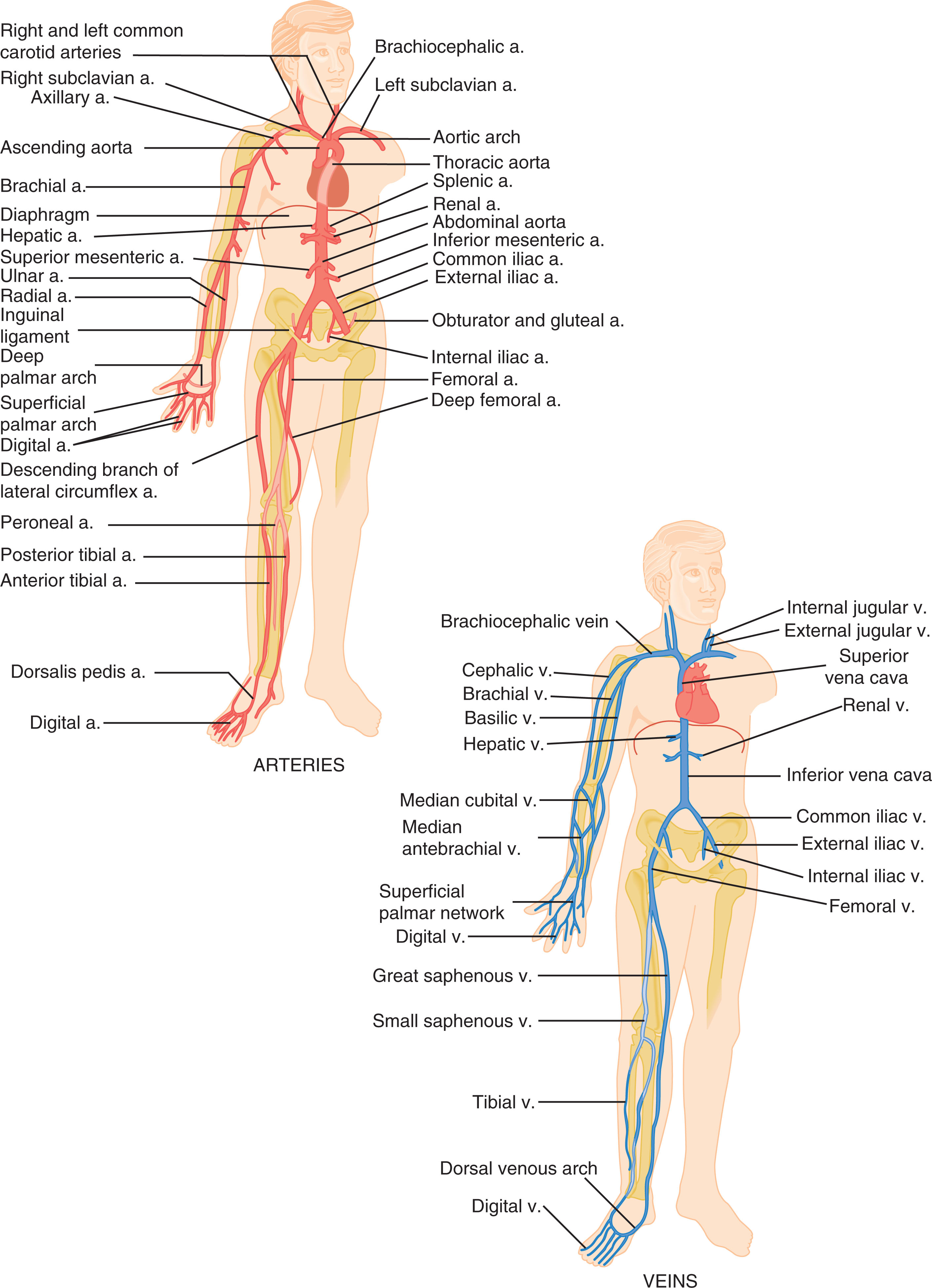
A typical artery in cross section consists of the following three layers ( Fig. 8.2A ):
Tunica intima (inner layer) consists of the following three layers: a layer of endothelial cells lining the arterial passage (lumen), a layer of delicate connective tissue, and an elastic layer made up of a network of elastic fibers.
Tunica media (middle layer) consists of elastin, smooth muscle fibers, and collagenous tissue. The media provides the strength of the aorta. Unfortunately, elastin is produced only minimally in the body. Therefore with increasing age, the elastin production is lost.
Tunica adventitia (external layer) consists of loose connective tissue with bundles of smooth muscle fibers and elastic tissue and carries nerves and the vaso vasorum. The vasa vasorum comprises the tiny arteries and veins that supply the walls of blood vessels.
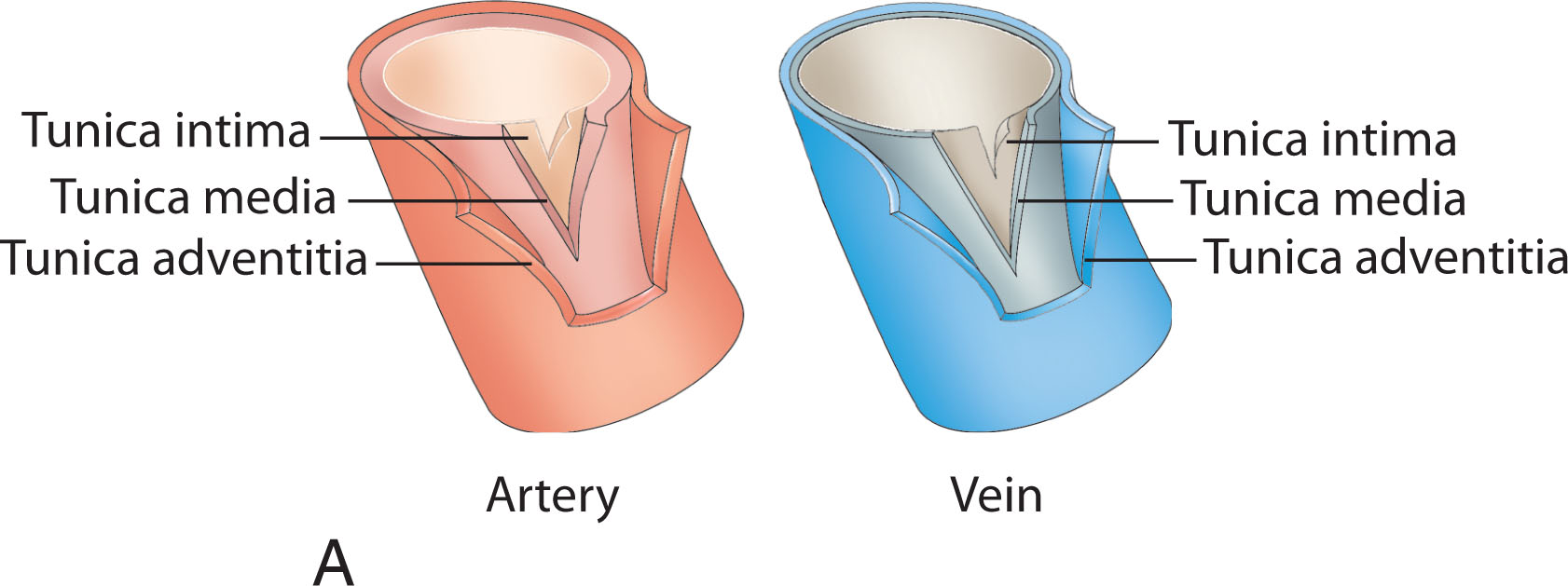
Specific differences exist between the arteries and the veins. The arteries are hollow elastic tubes that carry blood away from the heart. They are enclosed within a sheath that includes a vein and a nerve. The smaller arteries contain less elastic tissue and more smooth muscles than the larger arteries. The elasticity of the larger arteries is important in maintaining a steady blood flow. The abdominal aorta will not change in diameter with changes in respiration; however, pulsation of blood flow corresponding to the cardiac cycle will be noted.
The veins are hollow collapsible tubes with diminished tunica media that carry blood toward the heart. The veins appear collapsed because they have little elastic tissue or muscle within their walls (see Fig. 8.2B ). Veins have a larger total diameter than arteries, and they move blood more slowly. The veins contain special valves that prevent backflow and permit blood to flow in only one direction—toward the heart. Numerous valves are found within the extremities, especially the lower extremities, because flow must work against gravity. Venous return is also aided by muscle contraction, overflow from capillary beds, gravity, and suction from negative thoracic pressure. The sonographer may note that the inferior vena cava should dilate slightly with suspended respiration.
The capillaries are microscopic vessels just wide enough to let one red blood cell squeeze through. These tiny vessels connect the arterial and venous systems. Their walls have only one layer. The body's cells and tissues receive their nutrients from fluids passing through the capillary walls; at the same time, waste products from the cells pass into the capillaries. Arteries do not always end in capillary beds; some end in anastomoses, which are end-to-end grafts between different vessels that equalize pressure over vessel length and provide alternative flow channels.
The aorta is the largest principal artery of the body. It may be divided into the following five sections: (1) root of the aorta, (2) ascending aorta and arch, (3) descending aorta, (4) abdominal aorta and abdominal aortic branches, and (5) bifurcation of the aorta into iliac arteries (see Fig. 8.1B ).
The systemic circulation leaves the left ventricle of the heart by way of the aorta ( Fig. 8.3 ). The root of the aorta arises from the left ventricular outflow tract in the heart. The aortic root has three semilunar cusps that prevent blood from flowing back into the left ventricle. These cusps open with ventricular systole to eject blood into the ascending aorta; the cusps are closed during ventricular diastole. The coronary arteries arise superiorly from the right and left coronary cusps to form the right and left coronary arteries, respectively. These coronary arteries further bifurcate to supply the vasculature of the cardiac structures. After the aorta arises from the left ventricle, it ascends posterior to the main pulmonary artery to form the ascending aorta.
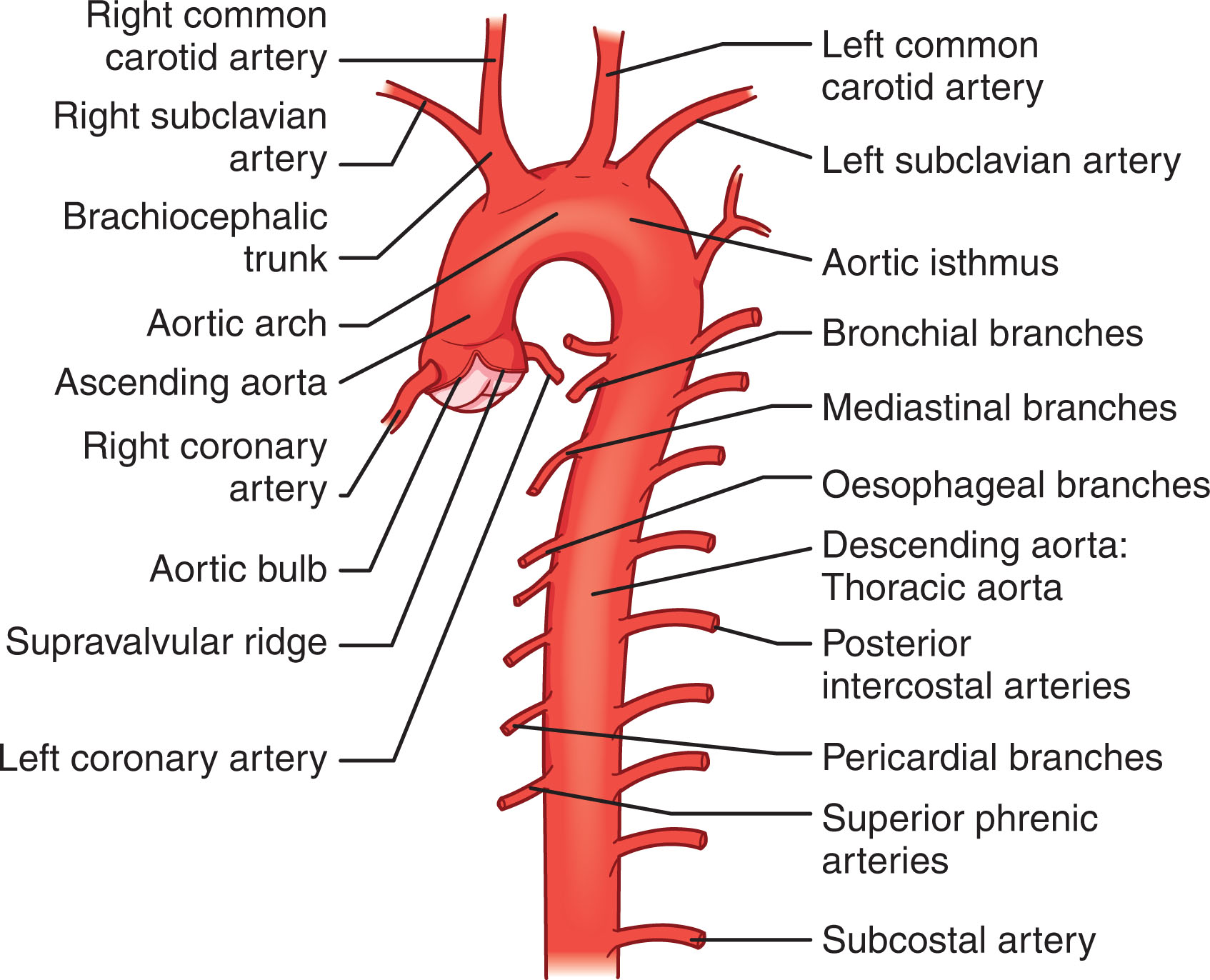
The ascending aorta arises a short distance from the ventricle and arches superiorly to form the aortic arch at the level of the sternoclavicular junction. Three arterial branches arise from the superior border of the aortic arch to supply the head, neck, and upper extremities: the brachiocephalic, left common carotid, and left subclavian arteries.
From the aortic arch, the aorta descends posteriorly along the back wall of the heart through the thoracic cavity, where it pierces the diaphragm to become the abdominal aorta. The descending (thoracic) aorta enters the abdomen through the aortic opening of the diaphragm anterior to the twelfth thoracic vertebra in the retroperitoneal space.
The abdominal aorta is the largest artery in the body that supplies blood to all visceral organs and the legs. The aorta continues to flow in the retroperitoneal cavity anterior and slightly left of the vertebral column. The aorta lies posterior to the left lobe of the liver, the body of the pancreas, the gastroesophageal junction, the pylorus of the stomach, and the splenic vein ( Fig. 8.4 ). The diaphragmatic crura surrounds the proximal abdominal aorta as this vessel projects through the diaphragm into the abdominal cavity ( Fig. 8.5 ). Many branches arise from the abdominal aorta: the celiac axis, superior mesenteric, inferior mesenteric, renal, suprarenal, and gonadal arteries ( Fig. 8.6 ). At the level of the fourth lumbar vertebra (near the umbilicus), the aorta bifurcates into the right and left common iliac arteries. The aorta has four branches that supply other visceral organs and the mesentery: the celiac trunk, the superior and inferior mesenteric arteries, and the renal arteries.
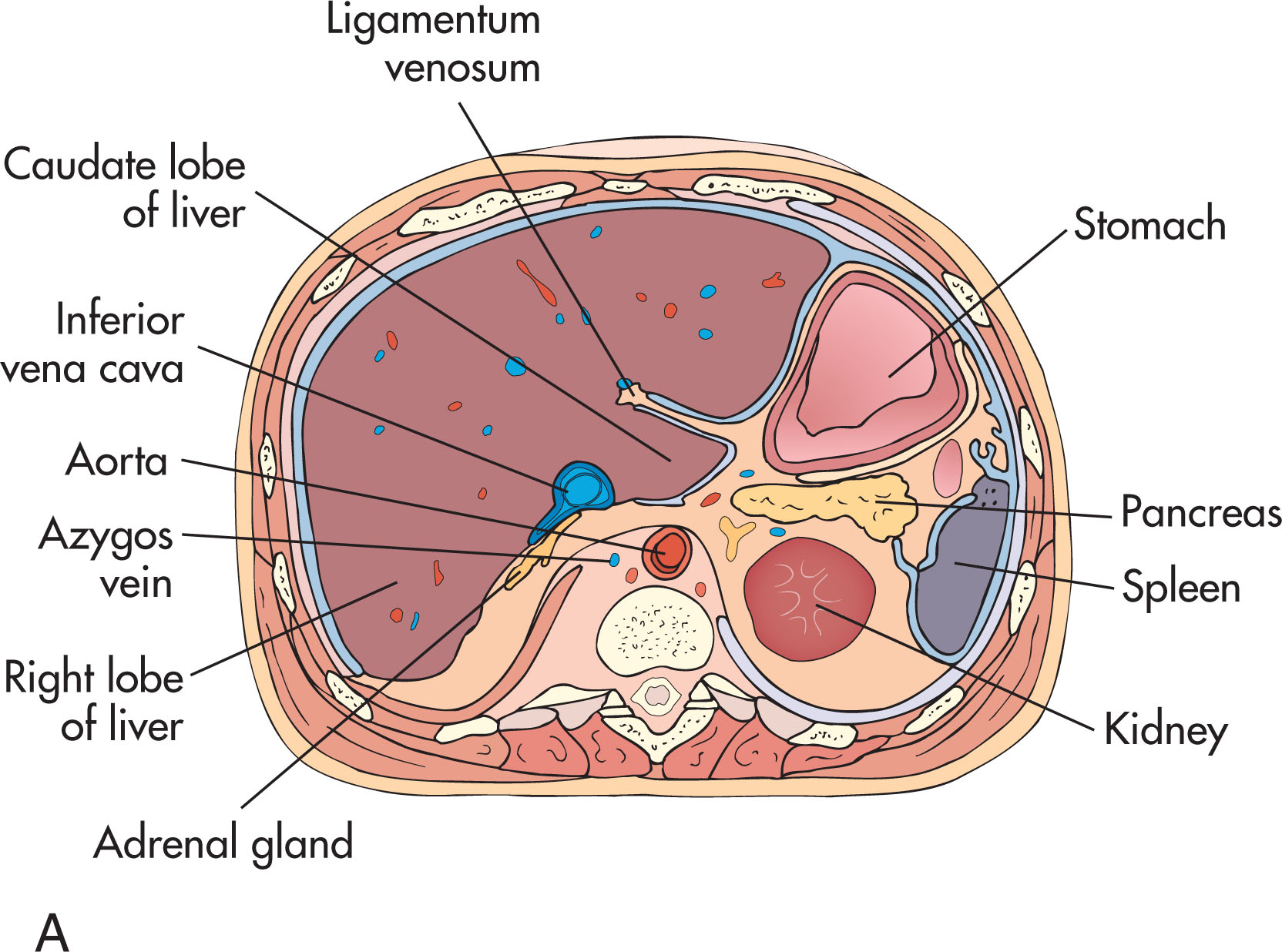
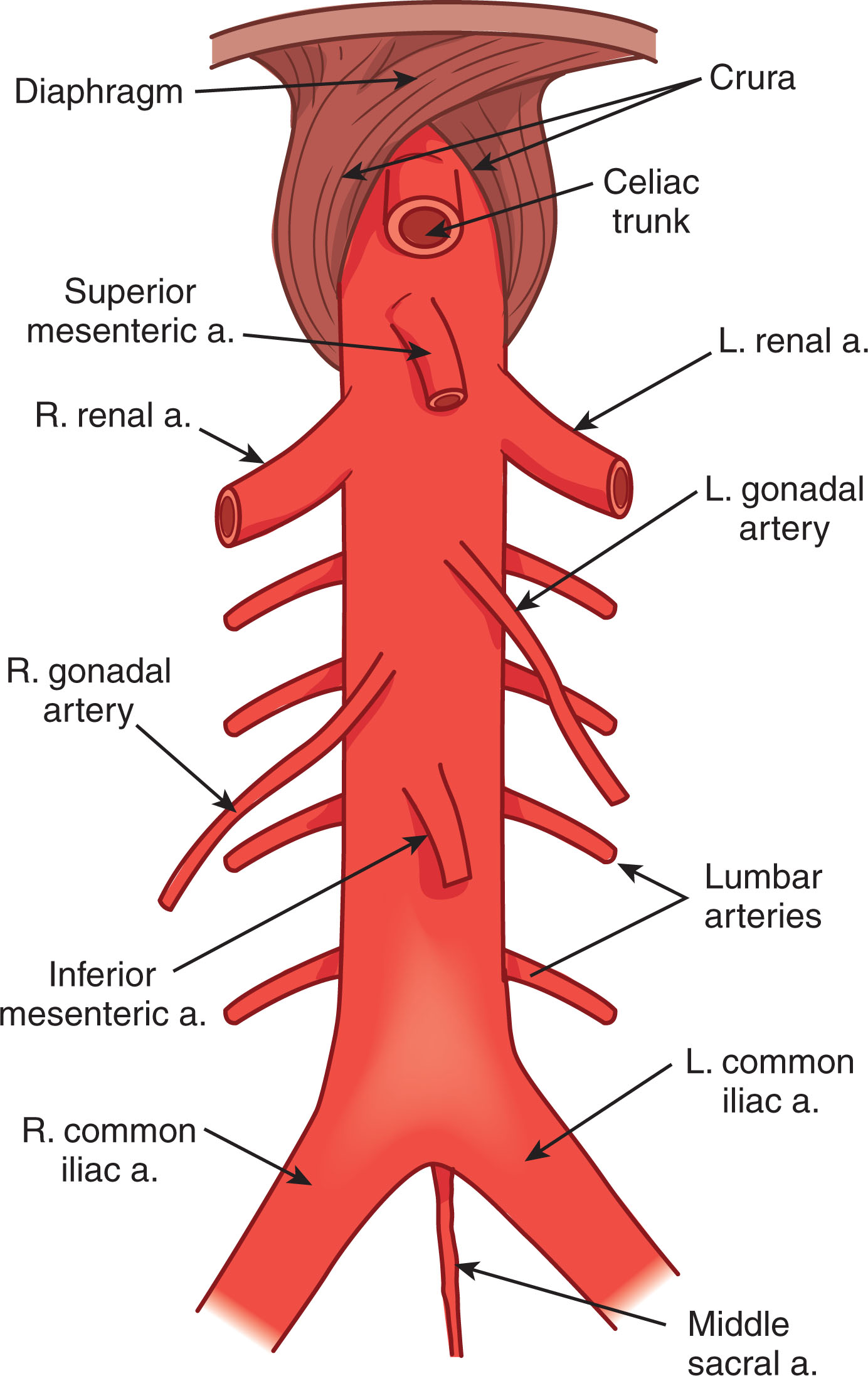
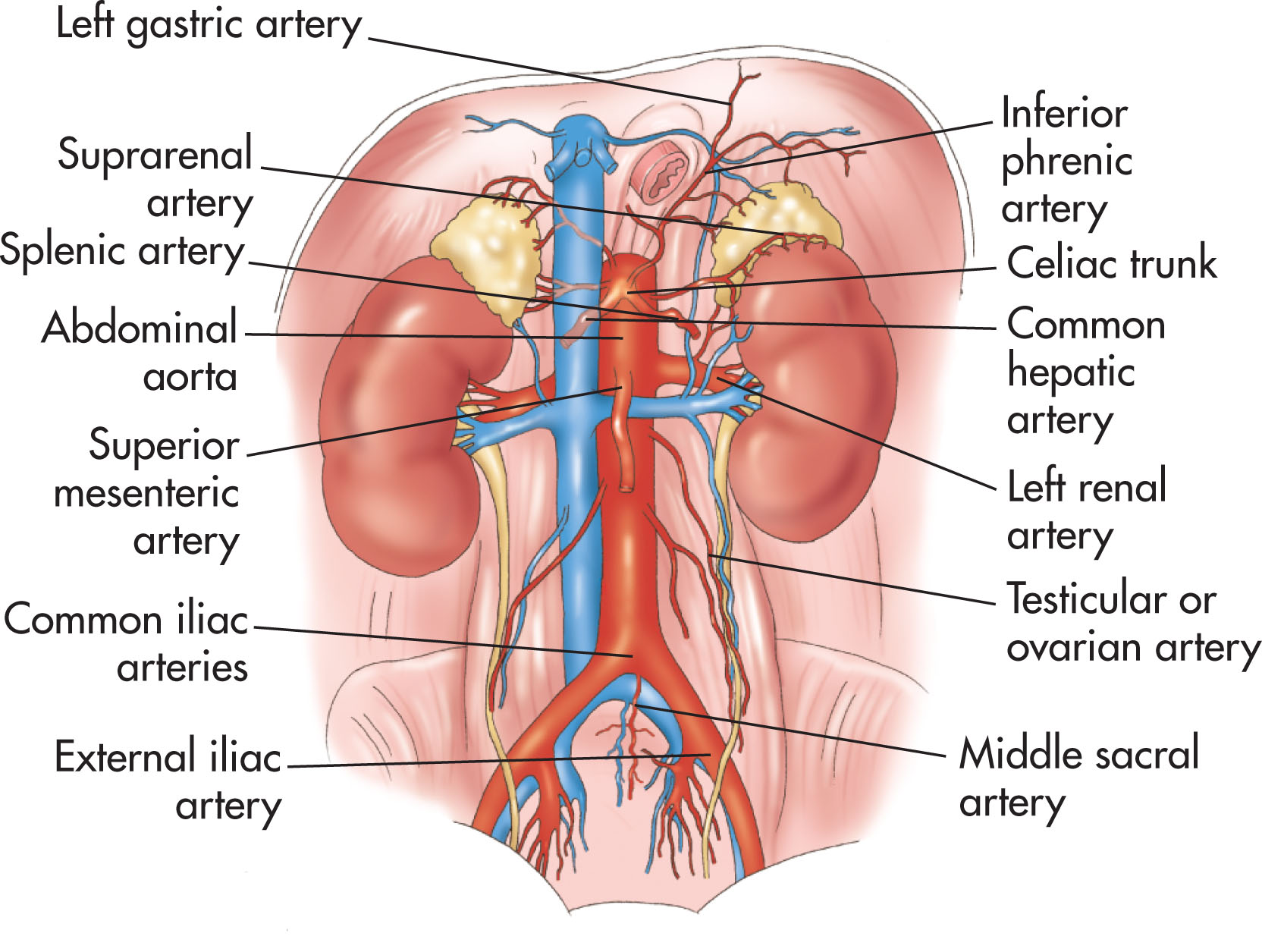
In most patients, the abdominal aorta is usually one of the easiest abdominal structures to image with ultrasound because of the marked change in acoustic impedance between its elastic walls and blood-filled lumen. Sonography provides the diagnostic information needed to create an image of the entire abdominal aorta, assess its diameter, and visualize the presence of thrombus, calcification, or dissection within the walls. Box 8.1 outlines the protocol to image the abdominal aorta.
The aorta is examined primarily to determine the presence of aneurysmal dilation.
Patient preparation: nothing by mouth for at least 6 h.
Transducer selection: 2.5–4 MHz curvilinear.
Patient position: supine or slightly decubitus.
Images and observations should include the following:
The aorta should be imaged in the longitudinal plane from the diaphragm to below the bifurcation at the iliac junction.
Transverse scans should be made at the diaphragm level, superior to the renal arteries, inferior to the renal arteries, and at the bifurcation. Scans of the iliac arteries should be made.
Lymphadenopathy should also be evaluated because the lymph nodes lie anterior to the vessels.
The inferior vena cava is best imaged on a longitudinal plane through the right lobe of the liver with the patient in full inspiration.
An alternative imaging plane is the slight decubitus view. The patient rolls onto his or her left side; the transducer is longitudinal and is sharply angled from the right lobe of the liver to the left iliac wing. This allows the sonographer to image the inferior vena cava “anterior” to the aorta. This view usually allows the sonographer to perform a shallow sweep to follow the entrance and exit of the renal veins and arteries into the great vessels and provides an excellent window to perform color flow or Doppler interrogation of the renal vessels.
Outer to outer measurements should be taken of the aorta in the longitudinal and transverse planes.
Multiple acoustic windows may be utilized to image the aorta. The traditional view is performed with the patient in the supine position. Gas-filled loops of bowel may prevent adequate visualization of the aorta, but this can sometimes be overcome by applying gentle pressure with the transducer or by changing the angle of the transducer to move the gas out of the way. An alternative imaging plane is made when the patient is rolled into a right lateral decubitus position and scanned along the left lateral flank with the transducer directed slightly toward the spine. (Recall that the aorta will be seen directly anterior to the spine.) Other visualization problems encountered in the abdominal aortic ultrasound may occur with increased mesenteric fat in obese patients. Patients should wait to be imaged at least 24 hours after a barium study or an endoscopic evaluation, as barium or air may still be a residual impairment to adequate visualization.
To begin the sonographic evaluation of the abdominal aorta, the patient is usually imaged first in the longitudinal plane. The aorta is imaged as a long pulsatile tubular structure that lies just anterior and to the left of the spine ( Fig. 8.7 ). The landmarks of the left lobe of the liver and the gastroesophageal junction may be seen anterior to the aorta. Longitudinal images should include the proximal, mid, and distal aorta to the bifurcation. The image acquisition should be made with the transducer perpendicular to the abdomen, beginning at the midline with a slight angulation of the transducer to the left of the spine, from the xiphoid to well below the level of bifurcation. In the average individual, the luminal dimension of the aorta gradually tapers as it proceeds distally in the abdomen. The abdominal aorta gives rise to two important branches from the anterior wall: the celiac trunk and the superior mesenteric artery (see Fig. 8.7D ).
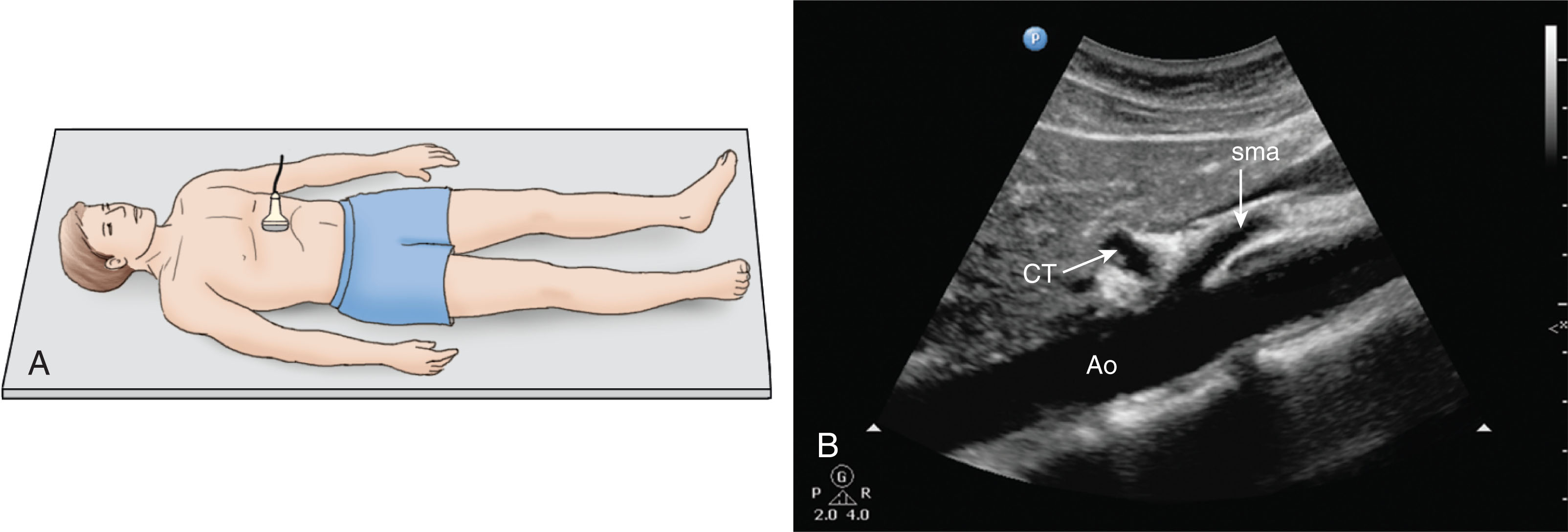
A low to medium gain should be used to demonstrate the walls of the aorta without “noisy” artifactual internal echoes. These weak echoes may result from increased gain, reverberation from the anterior abdominal wall fascia or musculature, or poor lateral resolution. These factors result in echoes being recorded at the same level as those from the soft tissue surrounding the vessel lumen, particularly if the vessels are smaller in diameter than the transducer. Try to use different techniques of breath-holding to eliminate these artifactual echoes. Sometimes, increased gentle pressure or change in angulation of the transducer may help displace bowel gas or may compress fatty tissue so that the transducer will be closer to the abdominal aorta. If the abdomen is very concave, the patient may be instructed to extend his or her abdomen (“push the abdomen muscle out”) to provide a better scanning plane. Color Doppler is useful to fully demonstrate the patent lumen of the aorta, from the diaphragm (celiac axis) to the bifurcation of the aorta into the iliac arteries ( Fig. 8.8 ).
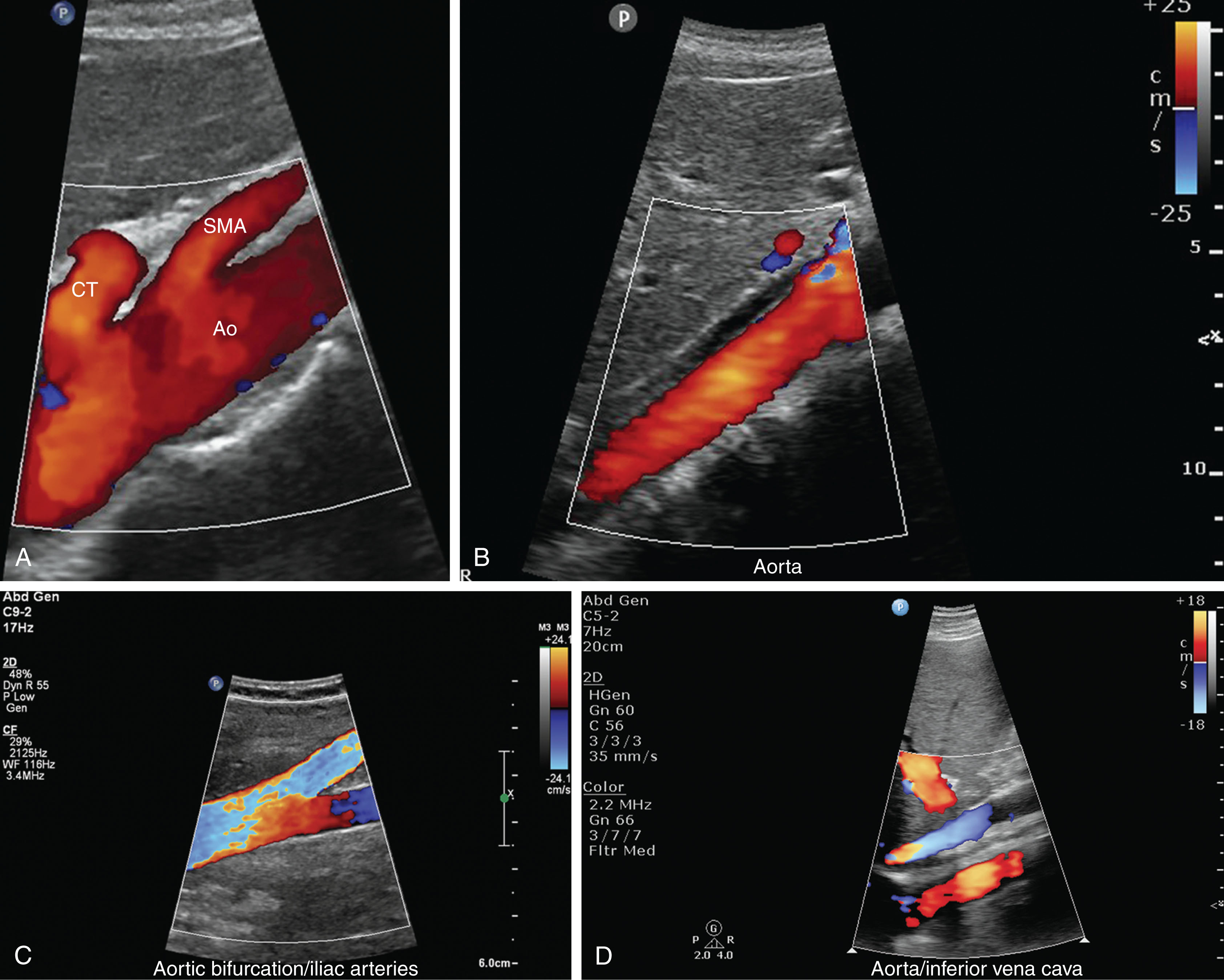
The coronal plane is useful when there is air-filled bowel obstructing the longitudinal plane. The patient may be rolled into a slight right decubitus position, and the transducer should be angled toward the midline to see the inferior vena cava and aorta. This view is excellent to image the renal arteries as they arise from the lateral wall of the aorta ( Fig. 8.9 ).
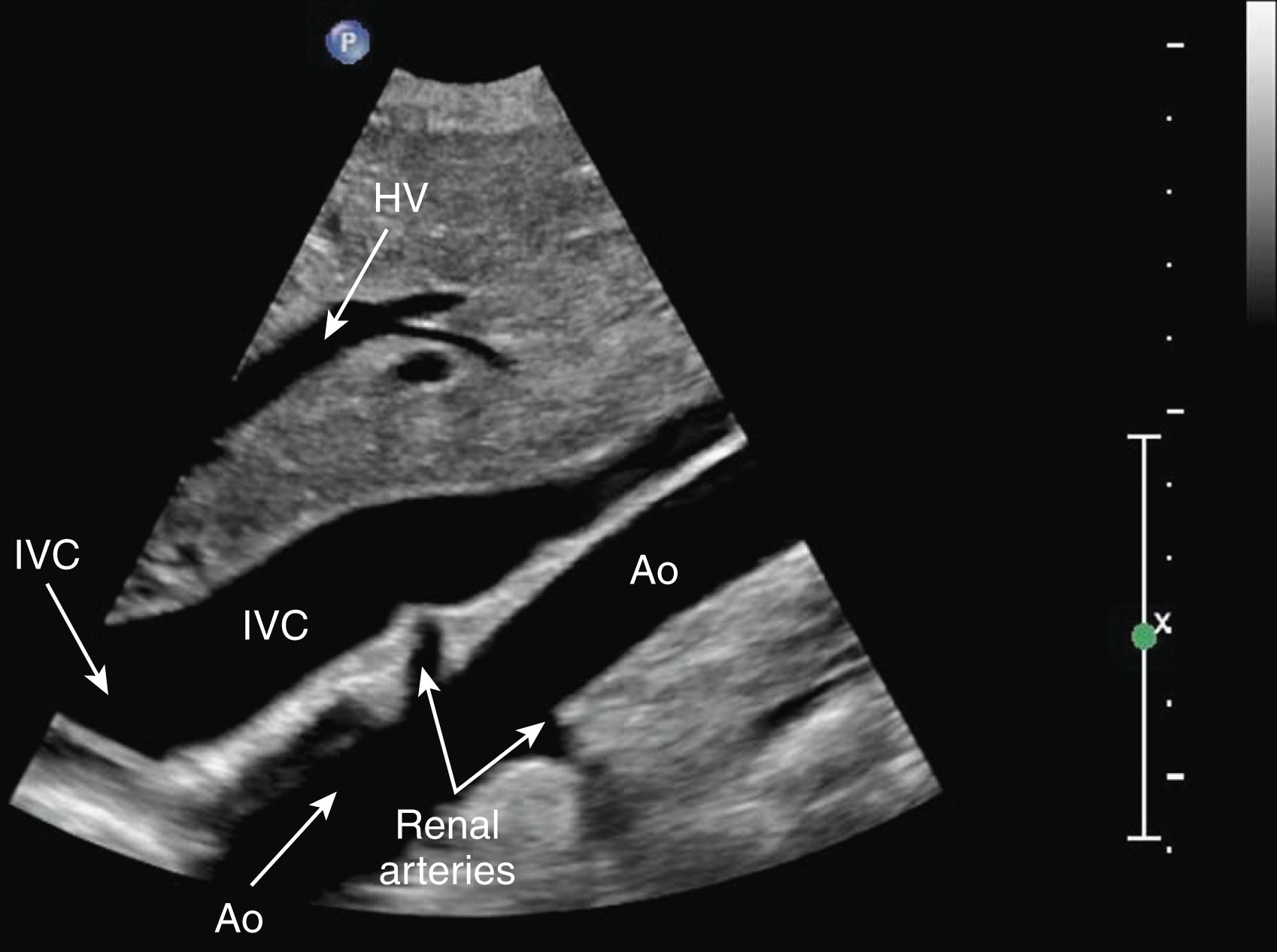
In the transverse plane, the aorta is imaged as a circular structure anterior to the spine and slightly to the left of the midline ( Fig. 8.10 ). In some cases, the transverse diameter of the aorta (anterior-posterior and width) differs from that found in longitudinal measurements; thus it is important to identify and measure the vessel in two dimensions. Multiple scans should be made from the xiphoid to the bifurcation to record the dimensions of the aorta at the diaphragm, just above the renal vessels, just inferior to the renal vessels, and at the level of the bifurcation.
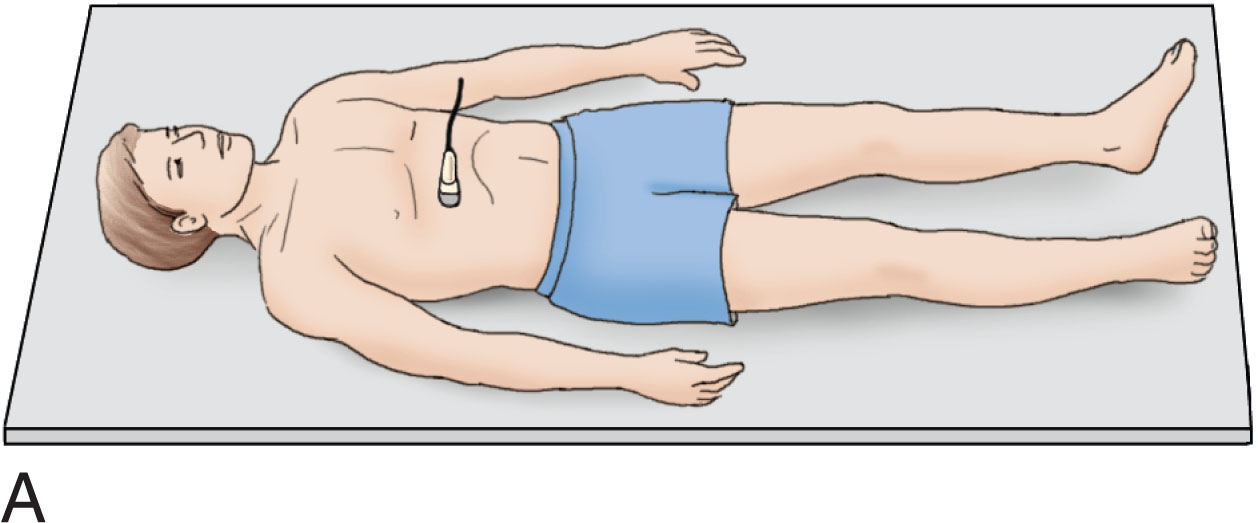
If the patient has a very tortuous aorta, scans may be difficult to obtain in a single longitudinal plane. The upper portion of the abdominal aorta may be well visualized during scanning in the longitudinal plane, but the lower portion may be out of the plane of view. In this case, the sonographer should obtain a complete scan of the upper segment and then concentrate fully on the lower segment. In some patients, the aorta may stretch from the far right of the abdomen to the far left. Transverse images of the aorta may be helpful to map the course of the vessel.
The aorta follows the anterior course of the vertebral column, and it is important that the transducer also follow a perpendicular path along the entire curvature of the spine. The anterior and posterior walls of the aorta should be easily seen as two thin pulsatile parallel lines. This facilitates measuring the anteroposterior diameter of the aorta, which in most institutions is done from the leading outer edge of the anterior wall to the outer edge of the posterior wall. Measurements are made at the proximal, mid, and distal aorta in the transverse and longitudinal planes. These measurements are made with the reduced gain setting from outer edge to outer edge at the greatest diameter ( Fig. 8.11 ).
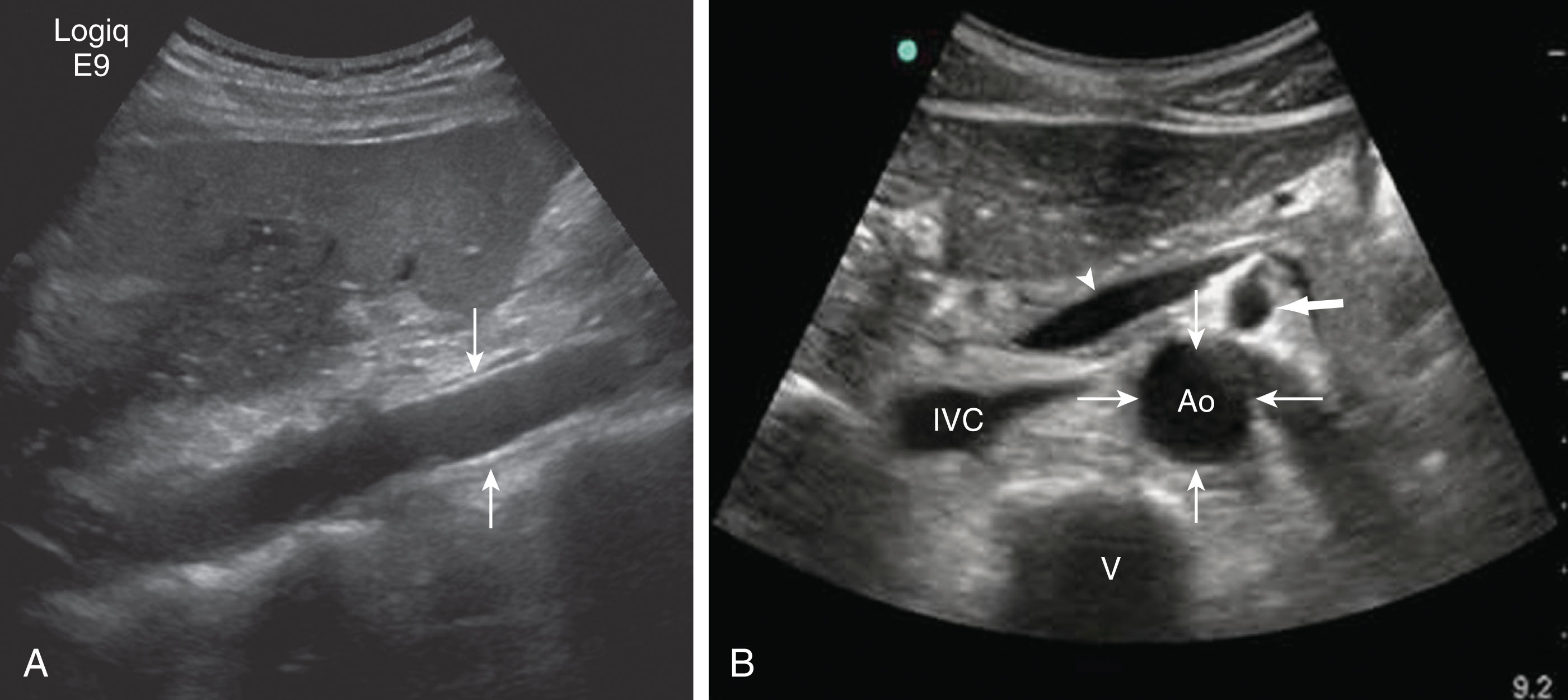
The sonographer should be careful to identify the posterior edge of the aorta as separate from the spine when performing the measurements. Calcification of the aorta or ossification of the spine may require careful analysis to make this measurement accurate.
The aortic diameter in men is slightly greater than in women. The proximal abdominal aorta tapers in size secondary to the three large branches (celiac, superior mesenteric, and renal arteries). In the supraceliac area, the aorta measures 2.5 to 2.7 cm in men and 2.1 to 2.3 cm in women. In the infrarenal area, the aorta measures 2.0 to 2.4 cm in men and 1.7 to 2.2 cm in women. There is gradual tapering to 1.1 to 1.5 cm in men and 1.1 to 1.3 cm in women at the bifurcation into the iliac arteries ( Table 8.1 ). The size of the aorta will vary slightly according to body mass index; the larger the body size, the greater is the measurement of the aorta. It is also important to note that the aorta does change in size as one grows older; therefore an aorta in a younger adult measuring 1.8 cm may increase to 2.2 cm by the time the adult reaches 60 years of age.
| Men | Women | |
|---|---|---|
|
|
|
| Common iliac artery | 1.1–1.5 cm | 1.0–1.3 cm |
| Common femoral artery | 0.9–1.2 cm | 0.8–1.0 cm |
If an aneurysm is present, the sonographer should measure and document the maximal size and location of the aneurysm. It is important to note the relationship of the dilated aortic segment in relation to the renal arteries and to note the extension into the iliac vessels.
The common iliac arteries arise at the bifurcation of the abdominal aorta at the fourth lumbar vertebra (near the superior sacrum). These vessels further divide into the internal and external iliac arteries ( Fig. 8.12 ). The internal iliac artery enters the pelvis anterior to the sacroiliac joint, at which point it is crossed anteriorly by the ureter. It divides into anterior and posterior branches to supply the pelvic viscera, peritoneum, buttocks, and sacral canal. The external iliac artery runs along the medial border of the psoas muscle, following the pelvic brim. The inferior epigastric and deep circumflex iliac branches branch off before they pass under the inguinal ligament to become the femoral artery. The portion of the femoral artery posterior to the knee is the popliteal artery. This artery further divides into the anterior and posterior tibial arteries.
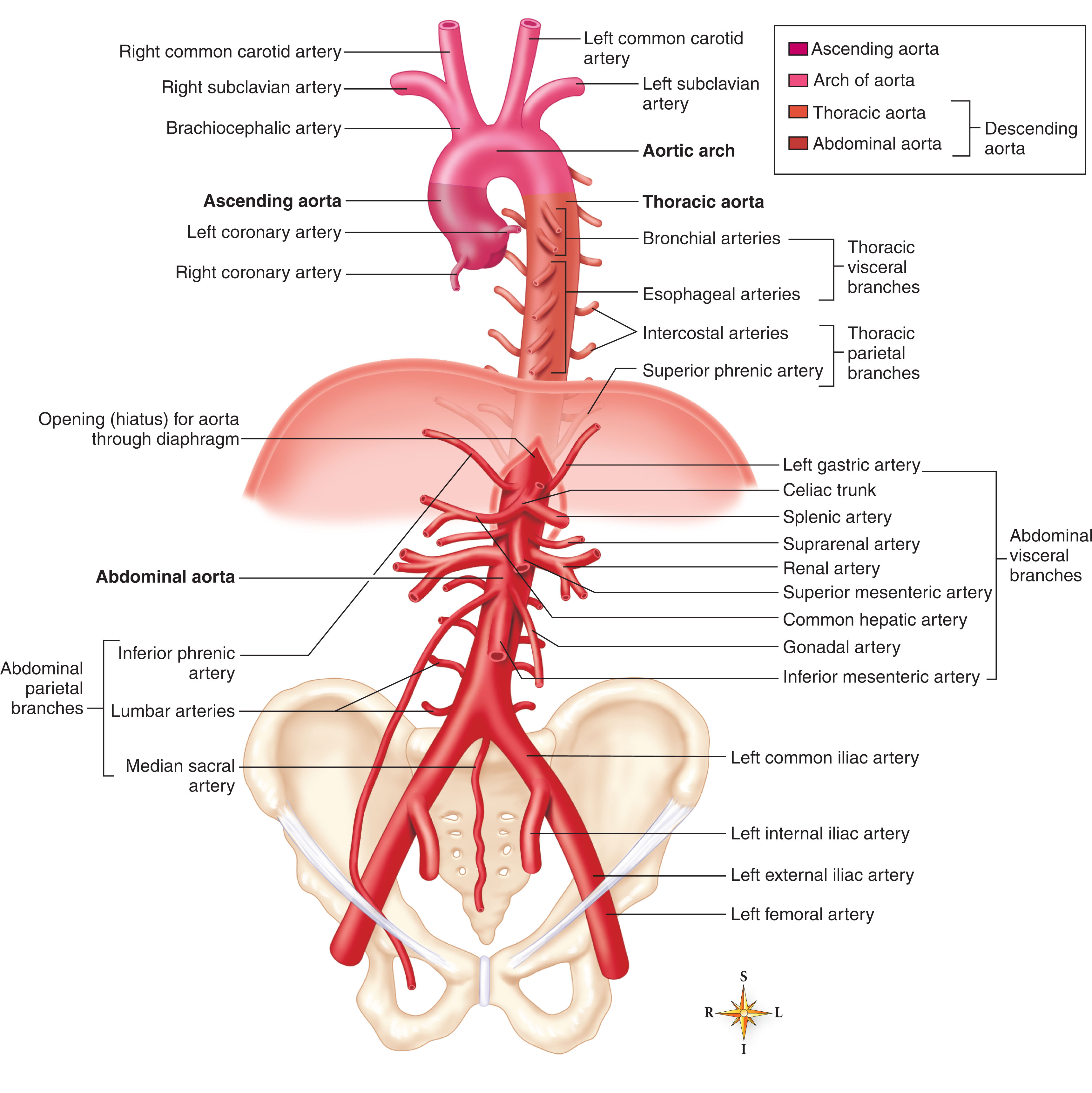
To better visualize the iliac arteries at the aortic bifurcation, use a slight lateral decubitus position. The patient should be rotated 5 to 10 degrees from the true lateral position. The patient should be examined in deep inspiration, which projects the liver and diaphragm into the abdominal cavity and provides an acoustic window to image the vascular structures. Slight medial to lateral angulation of the transducer may be necessary to image the bifurcation in the longitudinal plane. With the patient rolled into this oblique plane, the inferior vena cava may be visualized anterior to the aorta ( Fig. 8.13 ). The iliac arteries should measure less than 1.2 cm in the transverse anteroposterior diameter. It is common for the iliac arteries to be dilated if an aortic aneurysm is present, as most aneurysms develop inferior to the renal vessels near the bifurcation of the aorta. If the iliac artery measures greater than 3 cm, it may be considered for surgical repair.
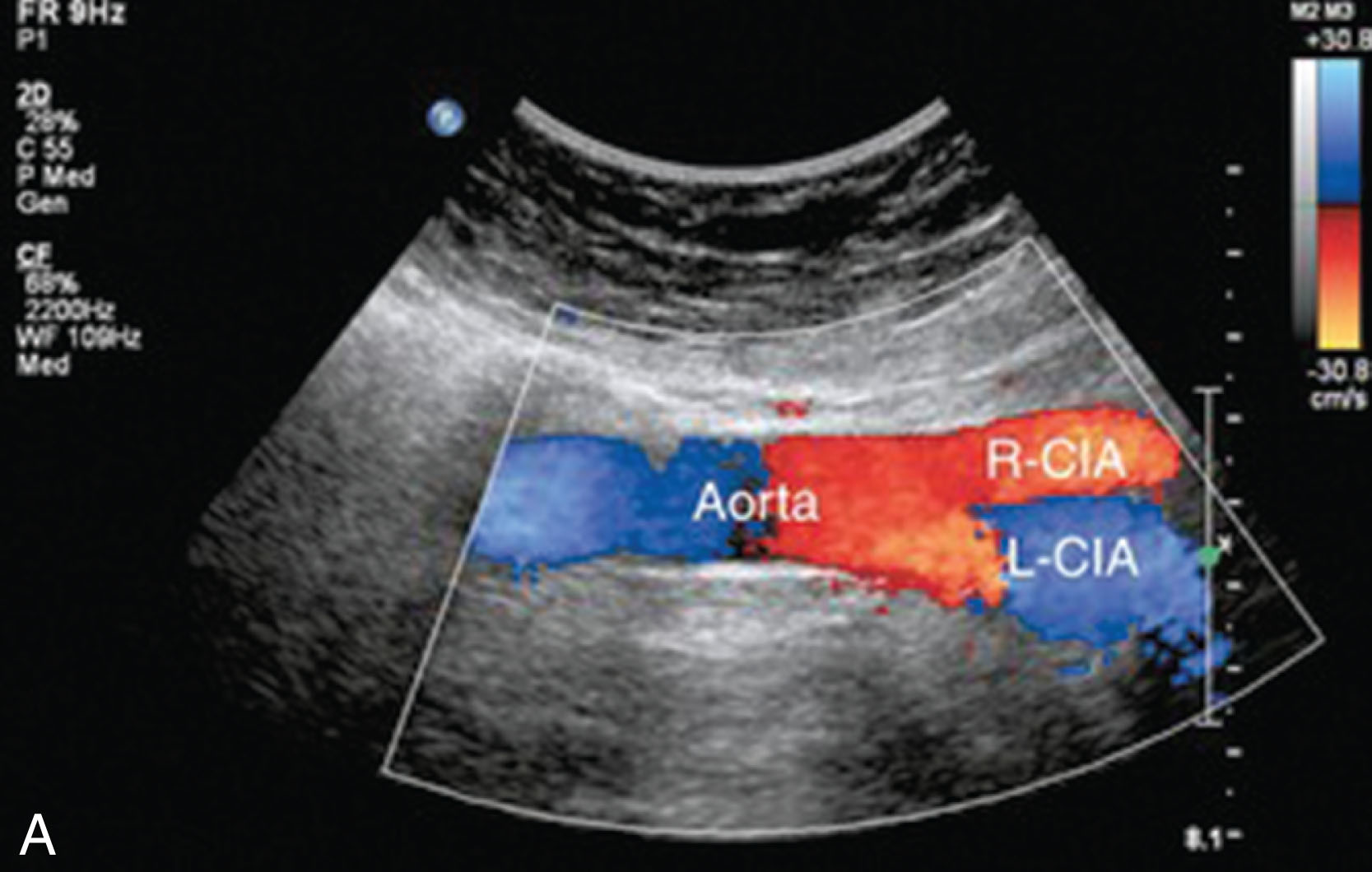
The small phrenic arteries arise from the lateral walls of the aorta to supply the undersurface of the diaphragm. Surgical intervention or trauma to the phrenic artery may cause limited movement of the diaphragm. The celiac trunk is the first anterior branch of the aorta, arising 1 to 2 cm inferior to the diaphragm. The median arcuate ligament surrounds the aorta and has been known to compress the celiac trunk. The short celiac trunk gives rise to three smaller vessels: the splenic, common hepatic, and left gastric arteries (see Fig. 8.12 ). The superior mesenteric artery is the second anterior branch, arising approximately 2 cm from the celiac trunk. The right renal artery and the left renal artery are lateral branches that arise just inferior to the superior mesenteric artery. The small inferior mesenteric artery arises anteriorly near the bifurcation. The distribution of these branch arteries is to the visceral organs and the mesentery.
The celiac trunk originates within the first 2 cm from the diaphragm ( Fig. 8.14 ). It is surrounded by the liver, spleen, inferior vena cava, and pancreas. After arising from the anterior wall, it immediately branches into the following three vessels: common hepatic, left gastric, and splenic arteries.
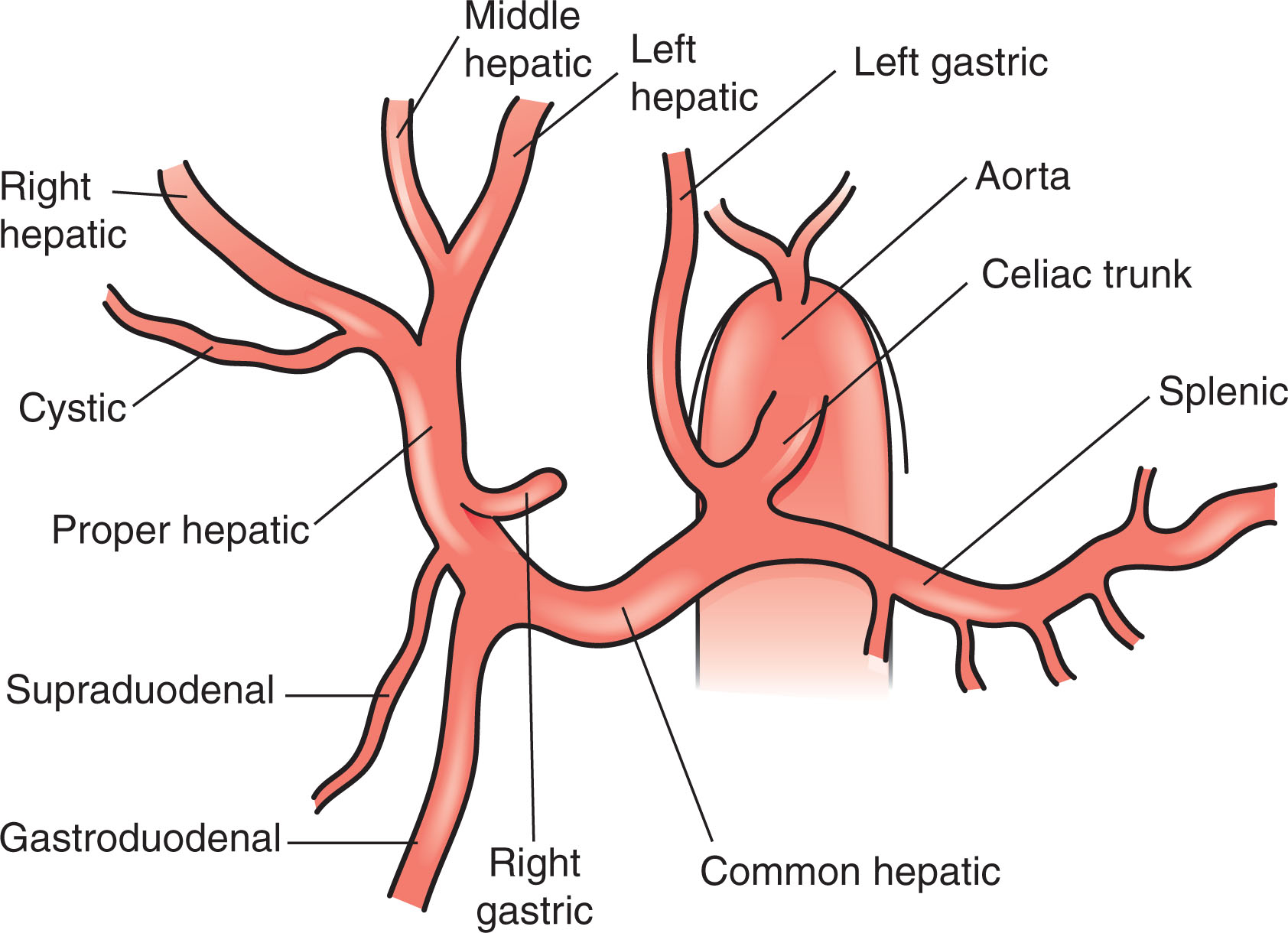
The common hepatic artery arises from the celiac trunk and courses to the right of the abdomen at almost a 90-degree angle (see Fig. 8.14 ). At this point, it branches into the proper hepatic artery and the gastroduodenal artery. The gastroduodenal artery courses along the upper border of the head of the pancreas, behind the posterior layer of the peritoneal bursa, to the upper margin of the superior part of the duodenum, which forms the lower boundary of the epiploic foramen (see Fig. 8.15 ). The duodenum and parts of the stomach are supplied by the gastroduodenal artery and the right gastric artery . Along with the hepatic duct and the portal vein, the common hepatic artery then ascends into the liver (through the porta hepatis), which divides into two branches: the right and left hepatic arteries.
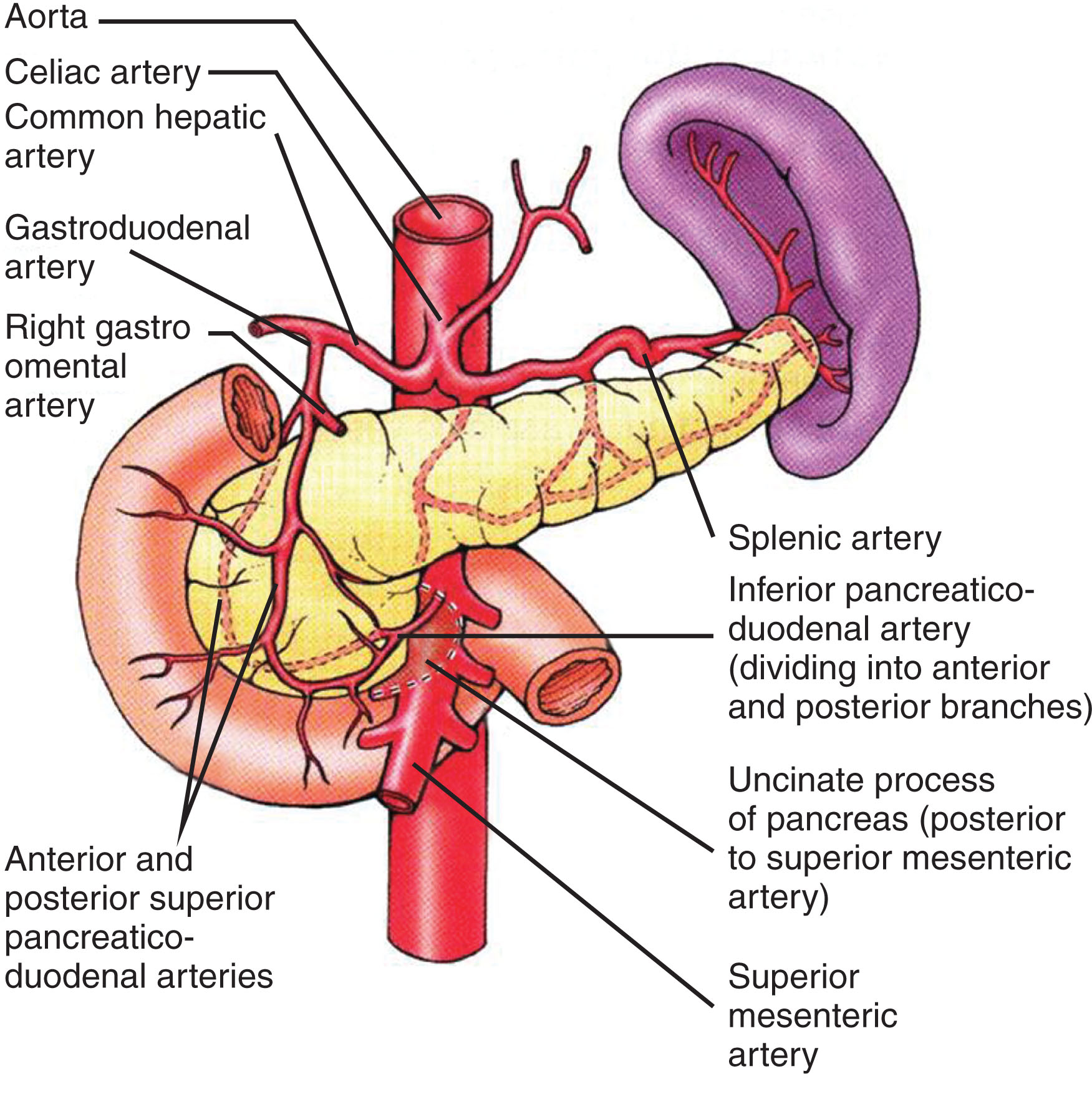
The left hepatic artery is a small branch of the proper hepatic artery supplying the caudate and left lobes of the liver. The right hepatic artery supplies the gallbladder via the cystic artery and the liver (see Fig. 8.14 ).
The left gastric artery is a small branch of the celiac trunk, passing anterior, cephalic, and left to reach the esophagus and then descending along the lesser curvature of the stomach (see Fig. 8.14 ). It supplies the lower third of the esophagus and the upper right of the stomach.
The splenic artery is the largest of the three branches of the celiac trunk (see Fig. 8.14 ). From its origin, the artery takes a somewhat tortuous course horizontally to the left as it forms the superior border of the pancreas. At a variable distance from the spleen, it divides into two branches. One of these branches, the left gastroepiploic artery, runs caudally into the greater omentum toward the right gastroepiploic artery. The other courses in a cephalic direction and divides into the short gastric artery, which supplies the fundus of the stomach, and into a number of splenic branches, which supply the spleen.
Several smaller arterial branches originate at the splenic artery as it courses through the upper border of the pancreas: the dorsal pancreatic, great pancreatic, and caudal pancreatic arteries. The dorsal or superior pancreatic artery originates from the beginning of the splenic artery or the hepatic artery, celiac trunk, or aorta. It runs behind and within the substance of the pancreas, dividing into right and left branches. The left branch is the transverse pancreatic artery. The right branch constitutes an anastomotic vessel to the anterior pancreatic arch and a branch to the uncinate process.
The great pancreatic artery originates from the splenic artery farther to the left and passes downward, dividing into branches that anastomose with the transverse or inferior pancreatic artery. The caudal pancreatic artery supplies the tail of the pancreas and divides into branches that anastomose with terminal branches of the transverse pancreatic artery. The transverse pancreatic artery courses behind the body and tail of the pancreas close to the lower pancreatic border. It may originate from or communicate with the superior mesenteric artery.
The distribution of the celiac trunk vessels is to the liver, spleen, stomach, pancreas, and duodenum.
The celiac trunk may be visualized sonographically on transverse or longitudinal images (see Fig. 8.16 ). It is usually seen as a small vascular structure arising anteriorly from the abdominal aorta just below the diaphragm. Because it is only 1 to 2 cm long, it is sometimes challenging to record unless the area near the midline of the aorta is carefully examined. Sometimes the celiac trunk can be seen to extend in a cephalic rather than a caudal presentation. The superior mesenteric artery is just inferior to the origin of the celiac trunk. The superior mesenteric artery may be used as a landmark in locating the celiac trunk. Transversely, one can differentiate the celiac trunk as the “wings of a seagull,” arising with its short trunk before dividing into the “wings” of the hepatic and splenic arteries.
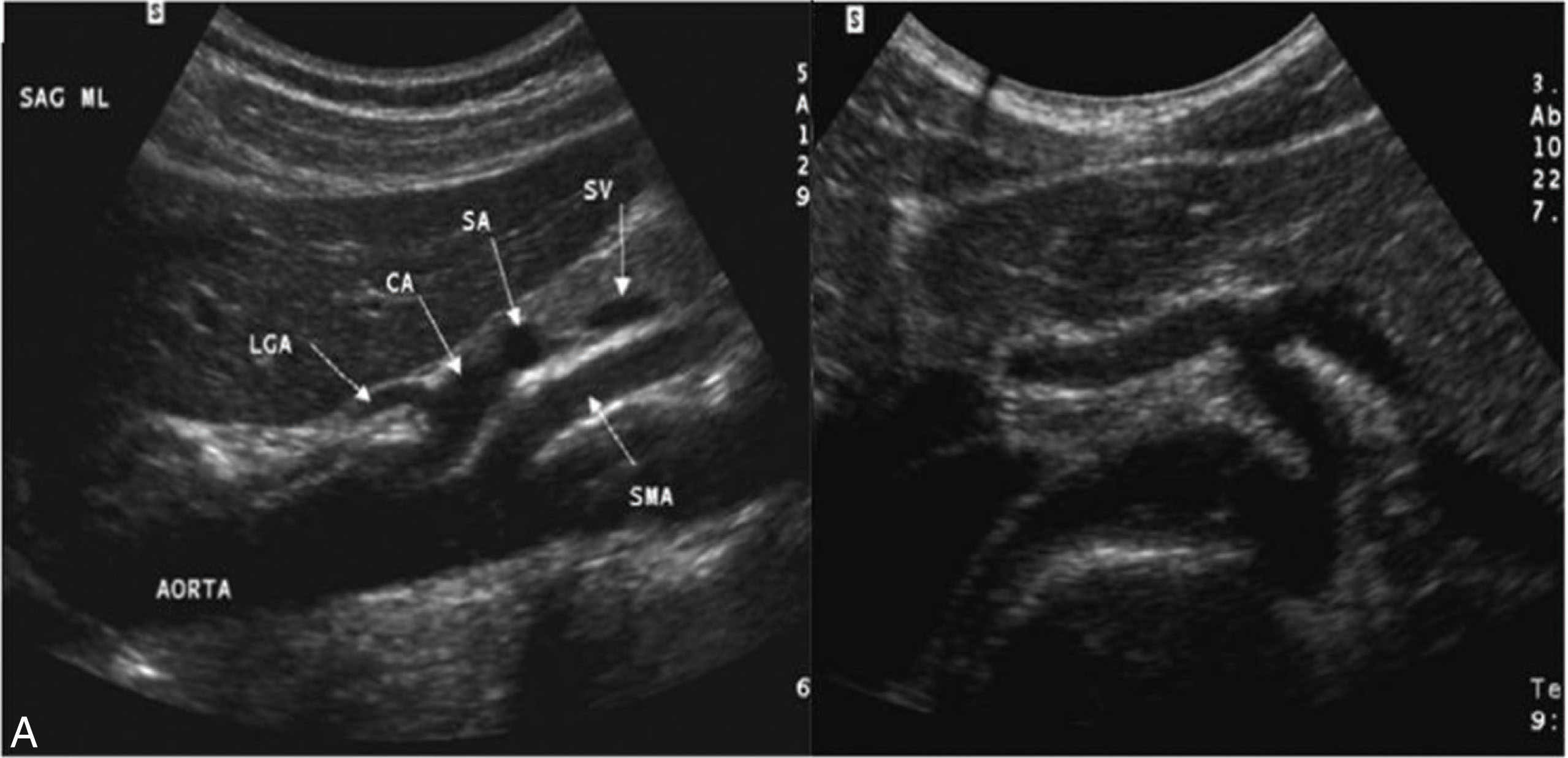
The splenic artery may be seen to flow directly from the celiac trunk toward the spleen (see Figs. 8.14 and 8.16 ). Because it is so tortuous, it may be difficult to follow on the transverse scan. Generally, small pieces of the splenic artery are visible as the artery weaves in and out of the left upper quadrant.
The common hepatic artery (see Fig. 8.15 ) can be seen to branch anterior and to the right of the celiac trunk, where it then divides into the right and left hepatic arteries in the liver (see Fig. 8.17 ). The sonographer should be aware of the many variations in the hepatic artery branches as seen in Fig. 8.18 .
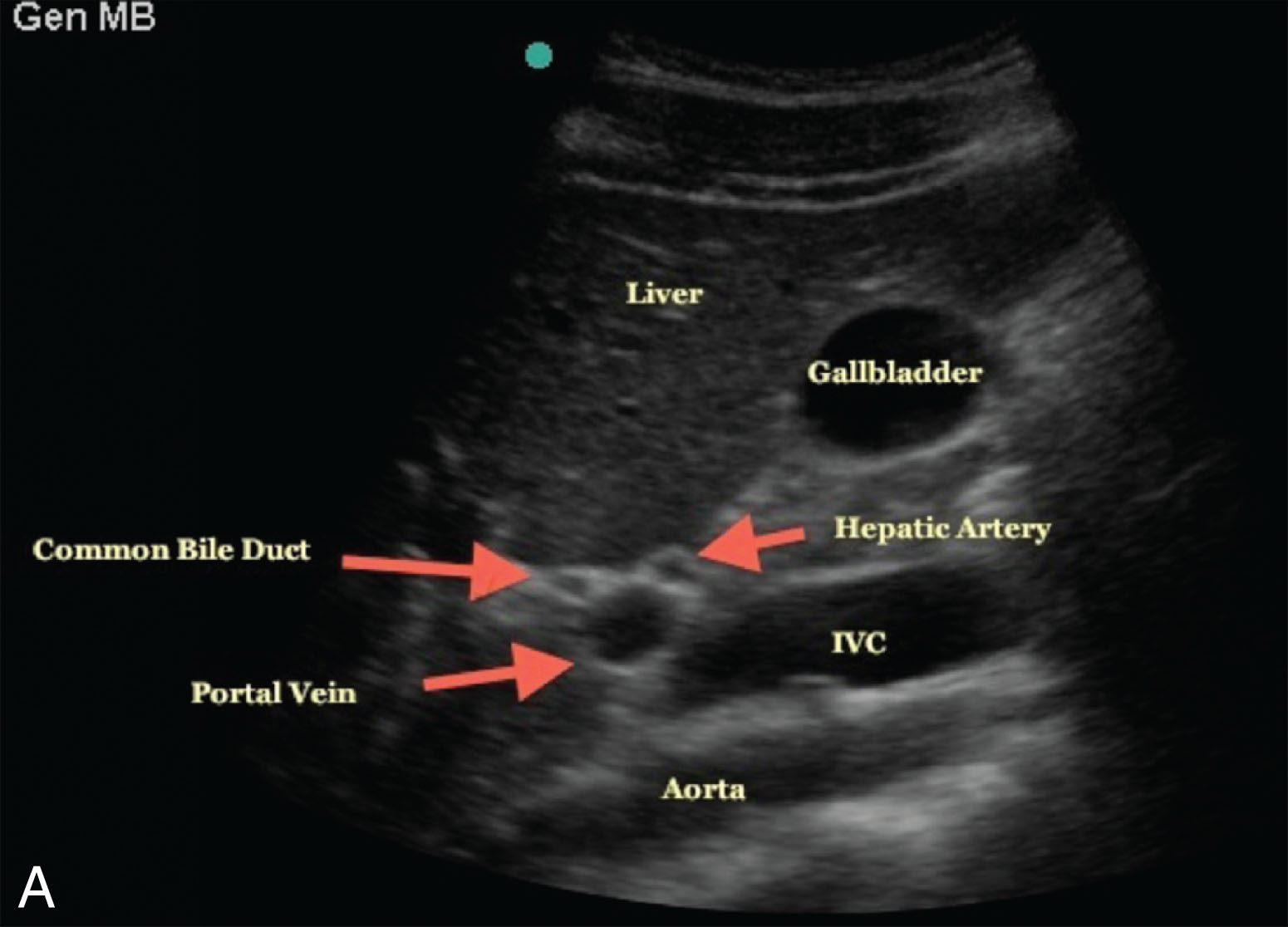
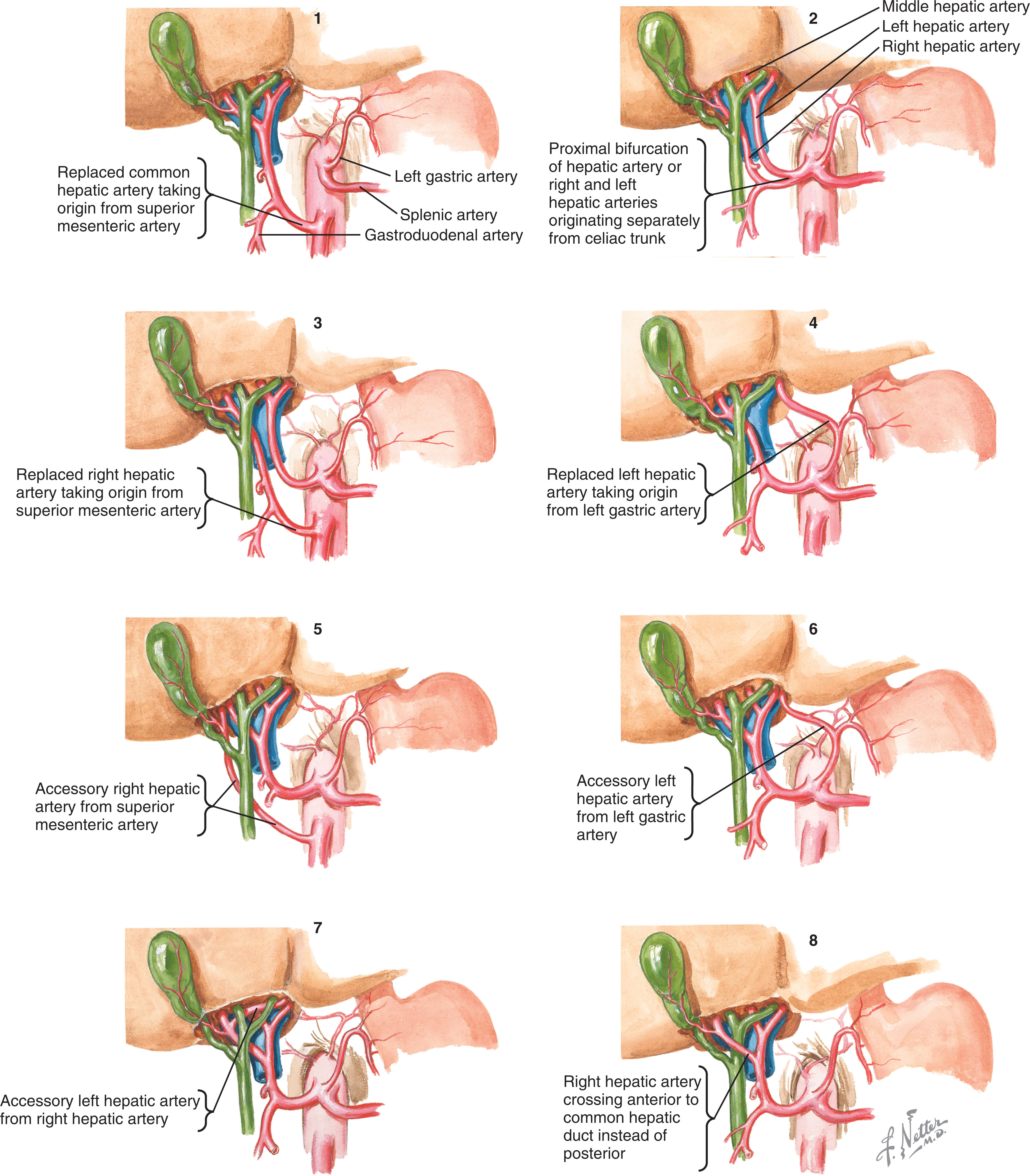
The left gastric artery (see Fig. 8.14 ) has a very small diameter and often is difficult to visualize with ultrasound. It becomes difficult to separate from the splenic artery unless distinct structures are seen in the area of the celiac trunk branching to the left of the abdominal aorta (see Fig. 8.16 ).
The superior mesenteric artery (SMA) arises from the anterior abdominal aortic wall approximately 1 cm inferior to the celiac trunk (see Fig. 8.12 ). Occasionally, the SMA may have a common origin with the celiac trunk. The SMA runs posterior to the neck of the pancreas and anterior to the uncinate process, which is anterior to the third part of the duodenum; it then branches into the mesentery and colon. The right hepatic artery is sometimes seen to arise from the superior mesenteric artery.
The SMA has the following five main branches (see Fig. 8.19 ): inferior pancreatic artery, duodenal artery, colic artery, ileocolic artery, and intestinal artery. These branch arteries supply the small bowel; each consists of 10 to 16 branches arising from the left side of the superior mesenteric trunk. They extend into the mesentery, where adjacent arteries unite with them to form loops or arcades. Their distribution is to the proximal half of the colon (cecum, ascending, and transverse) and the small intestine.
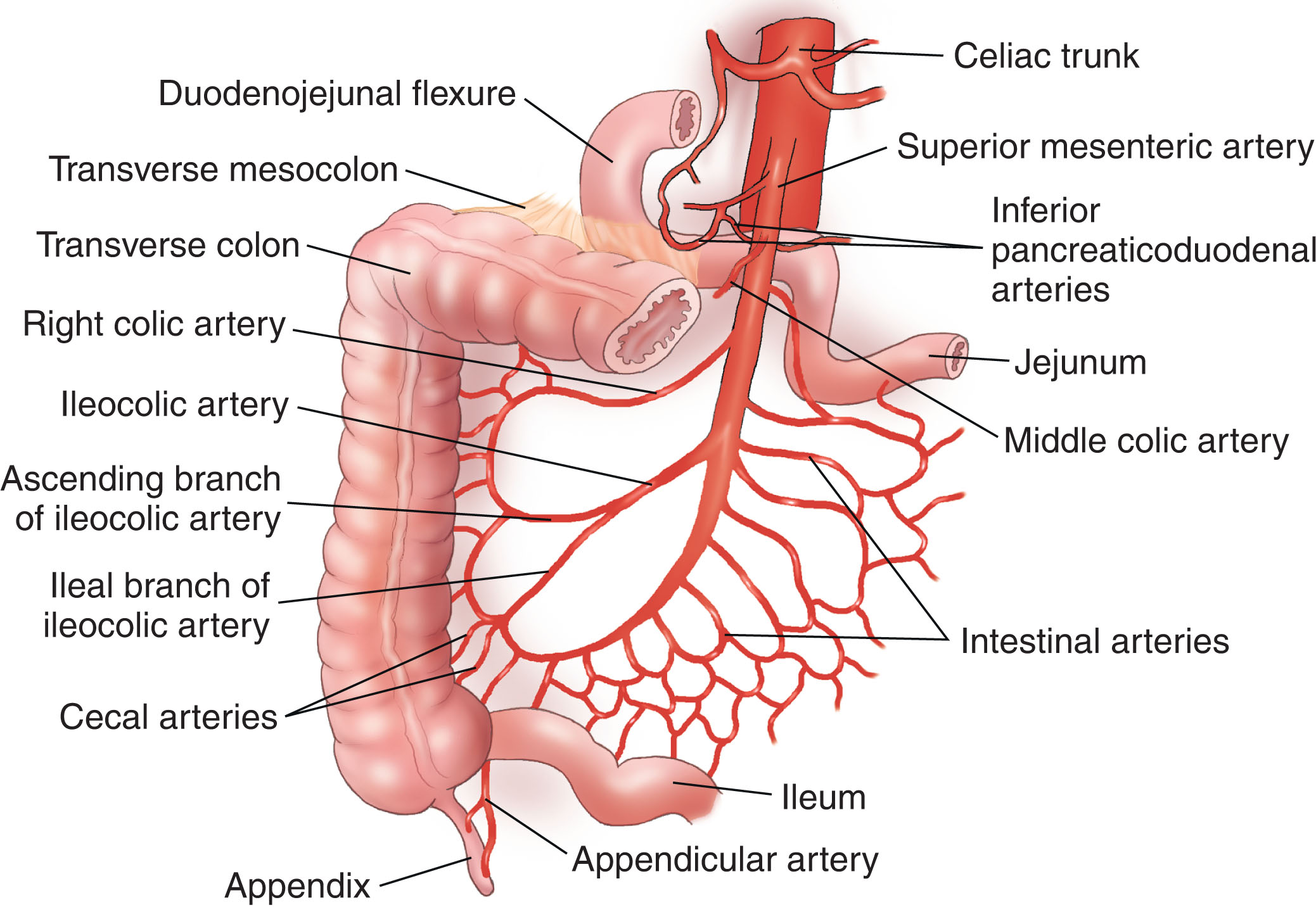
The SMA is well seen on both transverse and longitudinal scans (see Fig. 8.20 ). As it arises from the anterior aortic wall, the SMA branches off the anterior wall of the aorta at a slight angle and then follows a parallel course. Transversely, the artery can be seen as a separate small, circular structure anterior to the abdominal aorta and posterior to the pancreas. Characteristically, it is surrounded by highly reflective echoes from the retroperitoneal fascia.
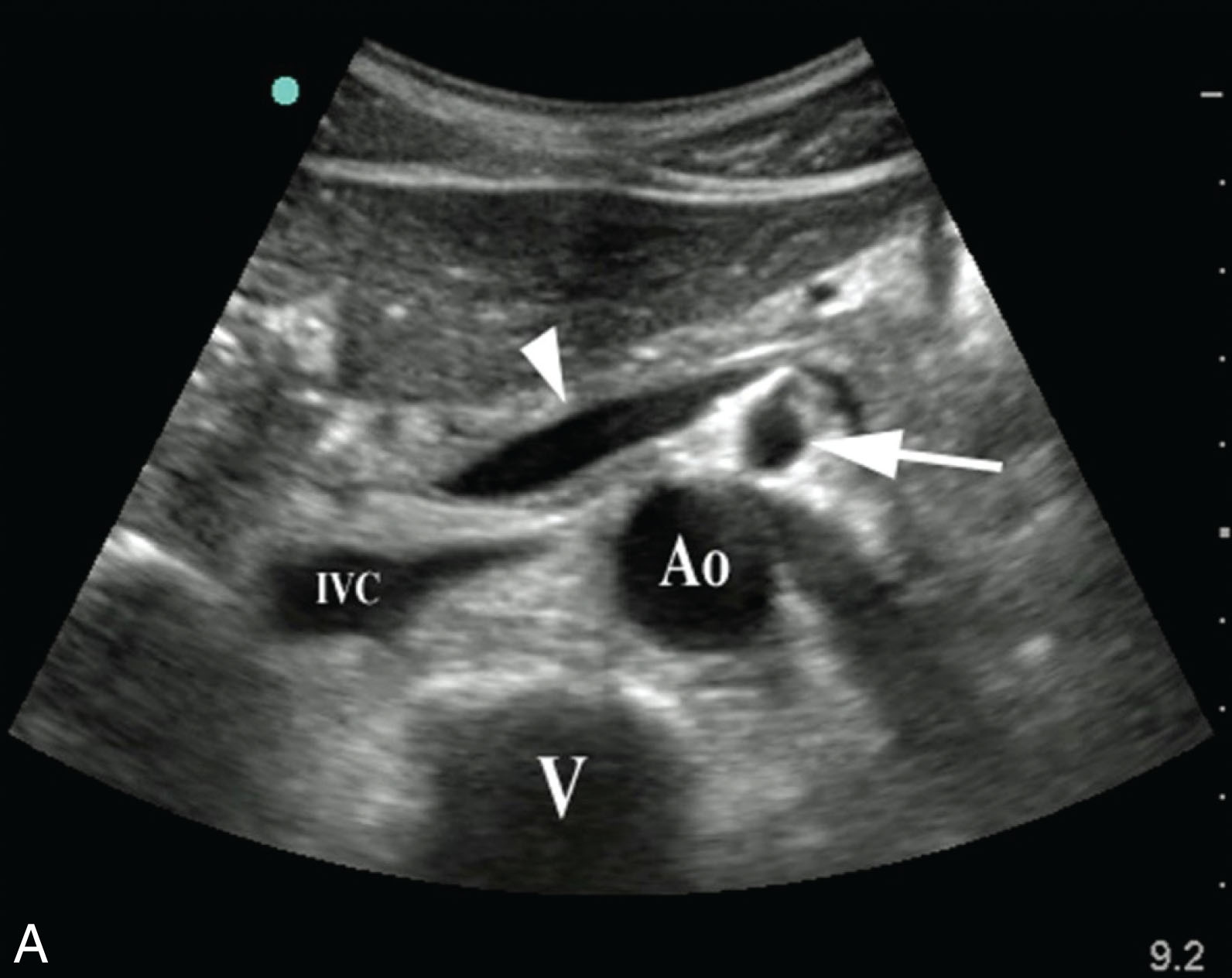
Adenopathy should be considered if the angle of the superior mesenteric to the aorta is severe (greater than 15 degrees).
The inferior mesenteric artery arises from the anterior abdominal aorta approximately at the level of the third or fourth lumbar vertebra (see Fig. 8.21 ). It proceeds to the left to distribute arterial blood to the descending colon, sigmoid colon, and rectum. It has the following three main branches: left colic, sigmoid, and superior rectal arteries. The distribution is to the left transverse colon, descending colon, sigmoid colon, and rectum.
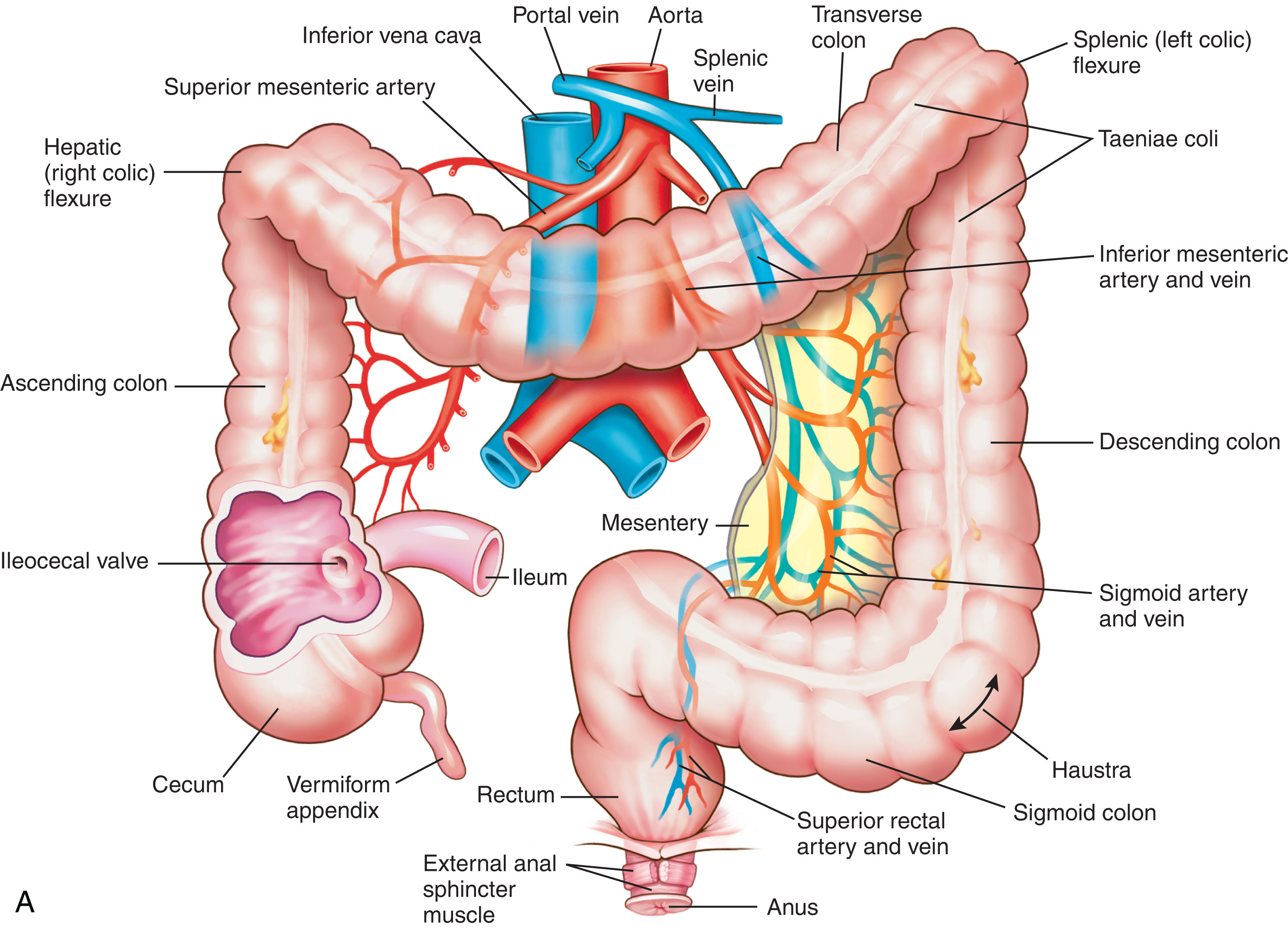
The inferior mesenteric artery is more difficult to visualize using ultrasound; it is generally on a longitudinal scan when it is seen. It is a small tubular structure inferior to the superior mesenteric artery, which originates from the anterior wall of the aorta. On transverse scans, it is difficult to separate from small loops of bowel within the abdomen.
The splanchnic aneurysms may be atherosclerotic, posttraumatic, mycotic, congenital, or inflammatory (see Fig. 8.22 ). A small percentage of patients with chronic pancreatitis may develop these aneurysms, which may occur in the SMA, hepatic and splenic arteries, gastroduodenal arteries, or inferior mesenteric artery. They may have mural thrombus that is well demonstrated with color Doppler.
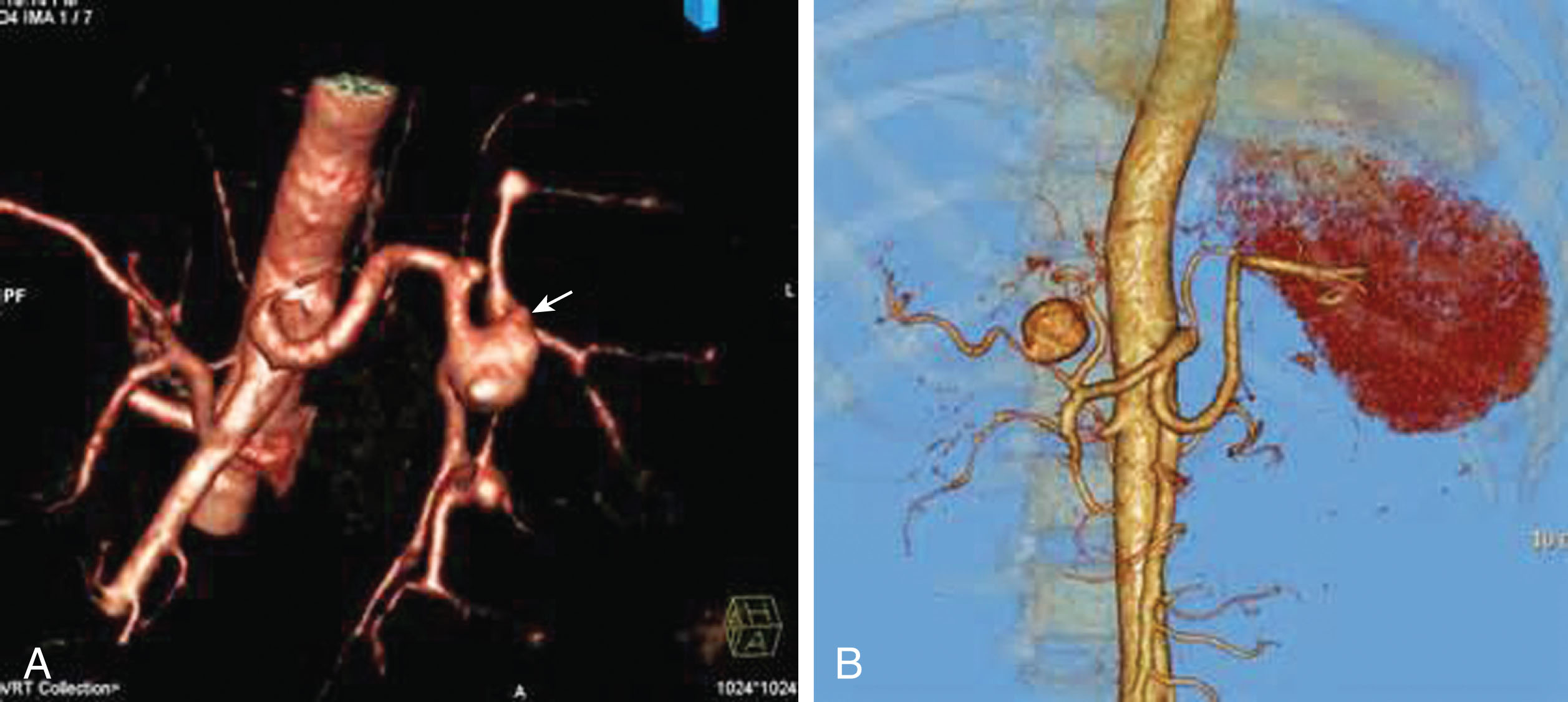
The phrenic arteries are paired small vessels that arise from the aorta's lateral wall to supply the diaphragm's undersurface (see Fig. 8.12 ).
The renal arteries arise from the lateral aspect of the aorta at the level of and anterior to the first lumbar vertebra, just inferior to the superior mesenteric artery ( Fig. 8.23 ). Both vessels divide into the anterior and inferior suprarenal arteries. Duplication of the renal arteries is not uncommon. The right renal artery is a longer vessel than the left; it courses from the aorta posterior to the inferior vena cava and anterior to the vertebral column in a posterior and slightly caudal direction to enter the hilus of the right kidney. The renal artery passes posterior to the renal vein before entering the renal hilus. The left renal artery courses from the aorta directly into the hilus of the left kidney.
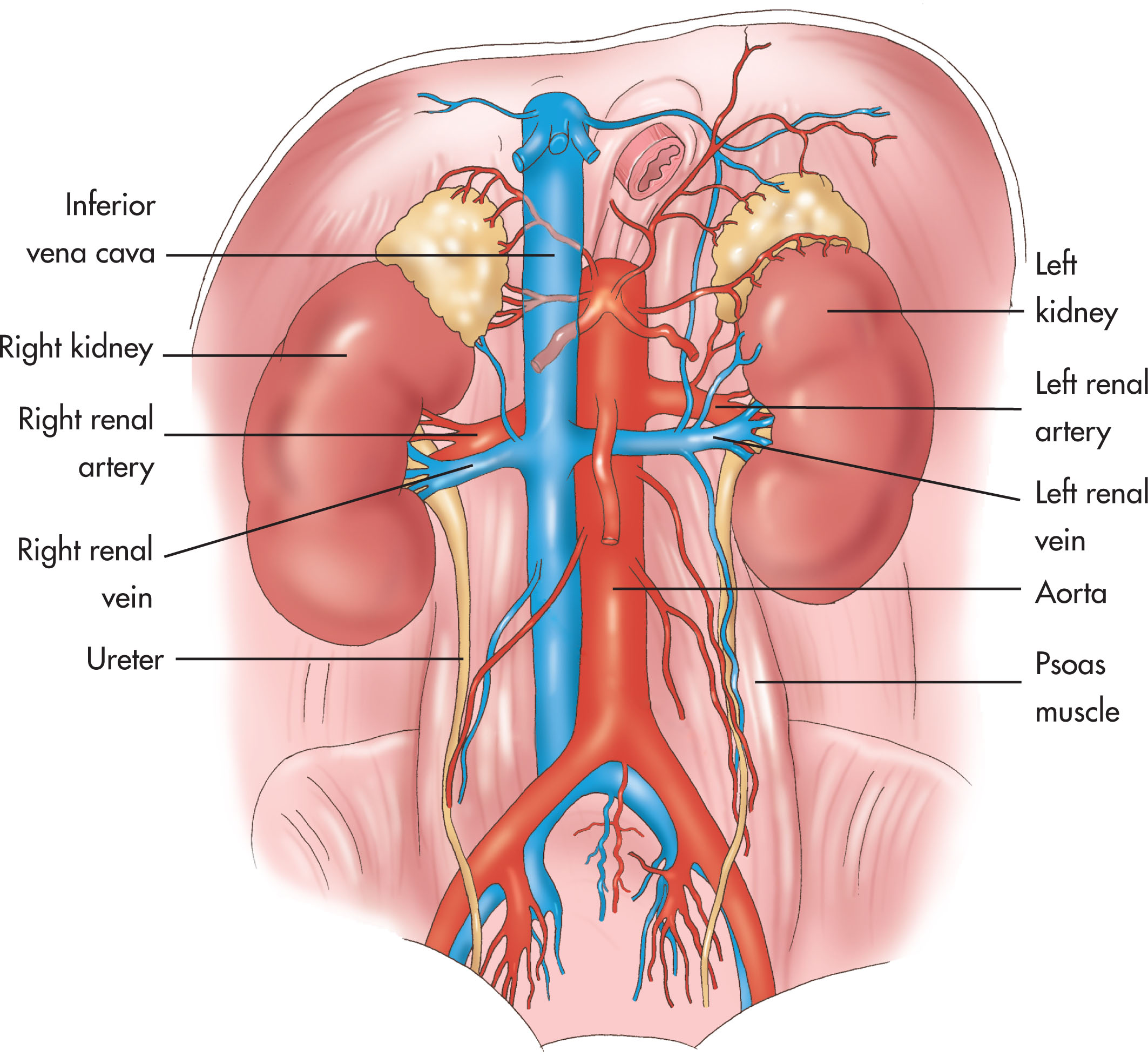
Both renal arteries are best seen on transverse sonograms. The right renal artery passes posterior to the inferior vena cava and anterior to the vertebral column in a posterior and slightly caudal direction ( Fig. 8.24 ). Occasionally, on longitudinal scans, a segment of the right renal artery is seen as a circular structure posterior to the inferior vena cava. The left renal artery takes a direct course from the aorta, anterior to the psoas muscle, to enter the renal sinus ( Fig. 8.25 ).
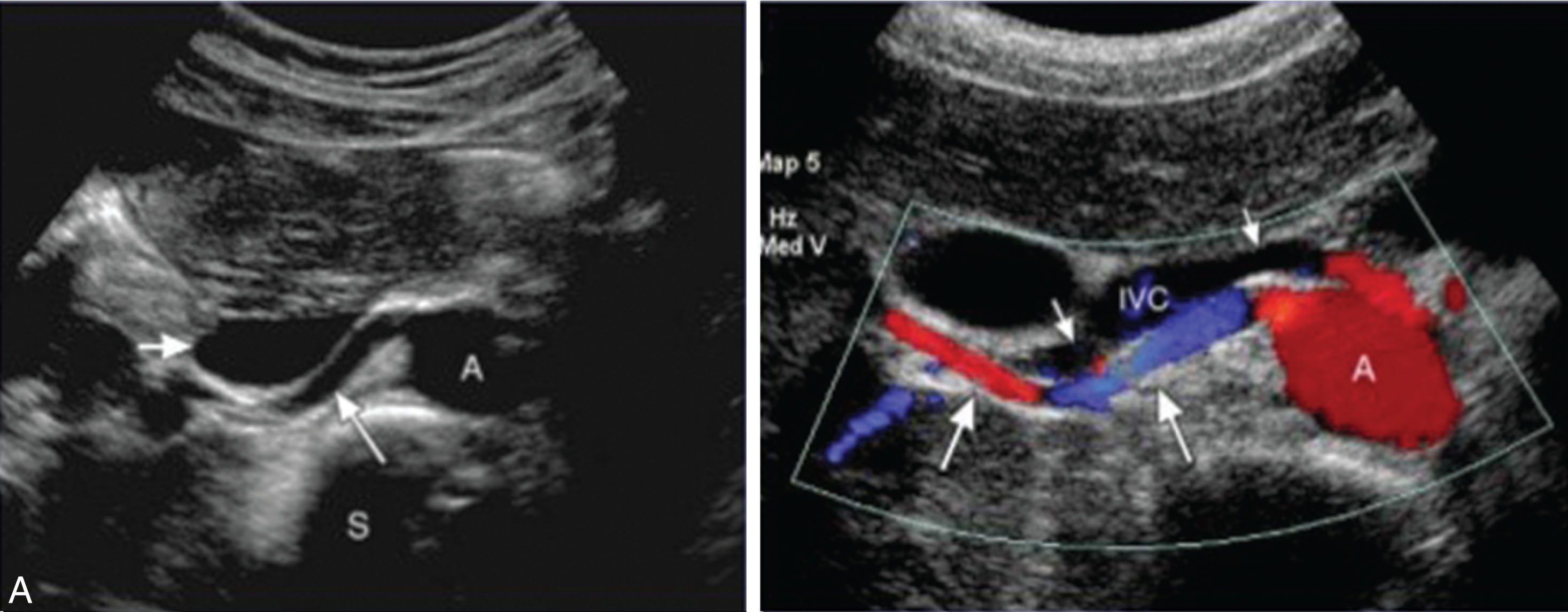
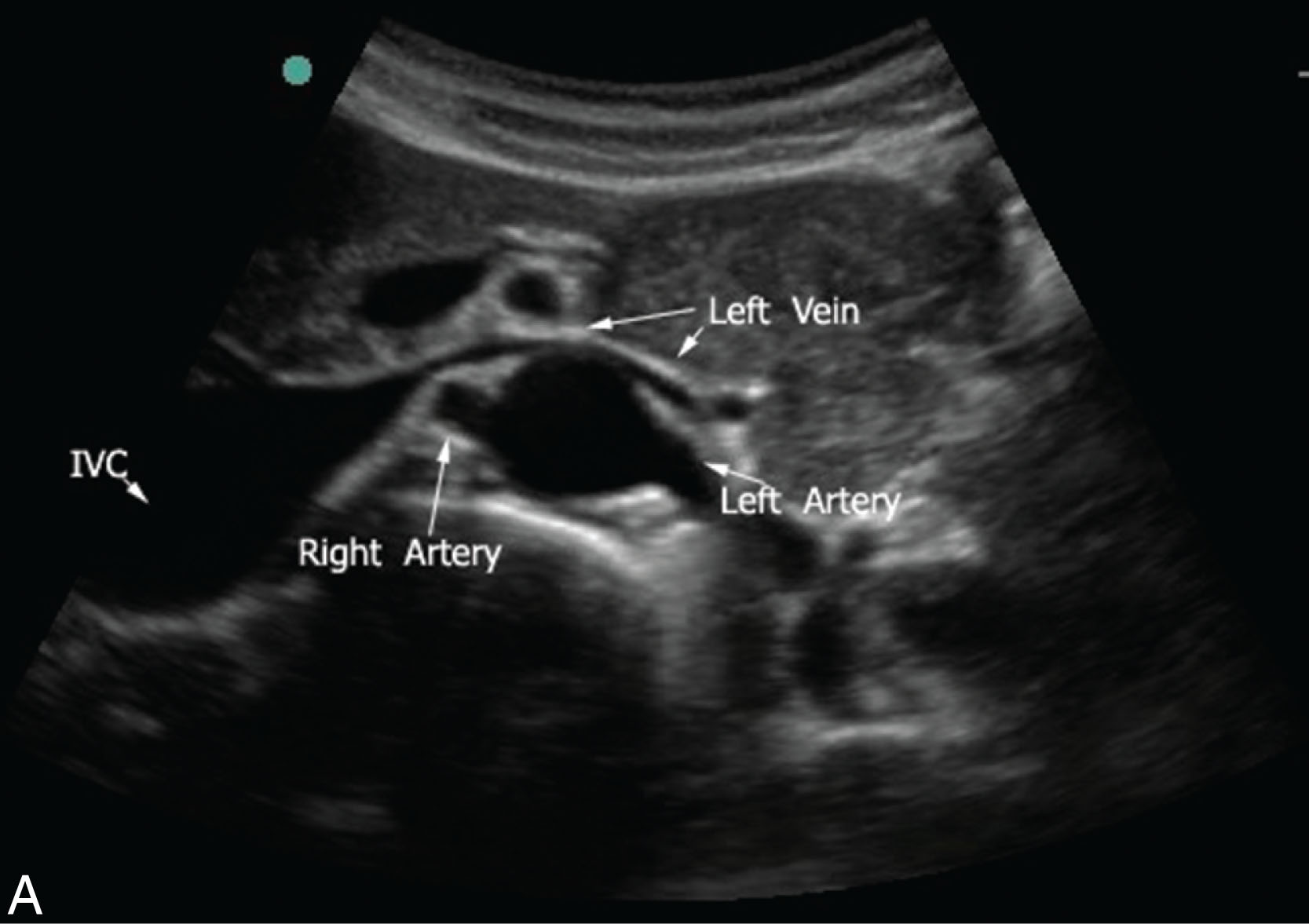
The coronal oblique scan of the aorta and inferior vena cava is excellent for demonstrating the origin of the renal arteries and veins (see Fig. 8.24D ). The patient is rolled into a steep decubitus position. The transducer is directed longitudinally with its axis across the inferior vena cava and aorta to see the origin of the renal vessels. The patient should be in full inspiration to dilate the venous structures for better visualization.
The gonadal artery arises inferior to the renal arteries and courses along the psoas muscle to the respective gonadal area (see Fig. 8.12 ).
Four lumbar arteries are usually present on each side of the aorta (see Fig. 8.12 ). The vessels travel lateral and posterior to supply muscle, skin, bone, and spinal cord. The midsacral artery supplies the sacrum and rectum.
The sonographer may be asked to evaluate the abdominal aorta for several clinical reasons: pulsatile abdominal mass, abdominal pain radiating to the back, an abdominal bruit, or hemodynamic compromise in the lower legs. The arterial system may be affected by atheroma, aneurysm, connective tissue disorder, rupture, thrombosis, or infection.
The sonographer has several objectives to meet when performing a complete evaluation of the abdominal aorta. Recall the discussion that the entire aorta should be imaged in at least two planes (transverse and longitudinal) with appropriate measurements of the aortic diameter in the proximal, mid, and distal segments. The real advantage for the sonographer is the ability to “follow” the vessel with the transducer. If the vessel is tortuous, the transducer should be rotated or angled slightly to follow the artery's course. The size of the aorta increases up to 25% in the seventh and eighth decades.
Distinguishing between aortic ectasia and an aneurysm of the aorta is essential. Ectasia implies the diffuse dilation of a vessel, whereas an abdominal aortic aneurysm is a region of focal enlargement ( Fig. 8.26 ). Ectasia occurs when the aorta increases both in transverse diameter and in vertical length, which causes the distal aorta to “kink,” usually anterior and to the left. The aorta may be “folded,” or tortuous, in its course, providing a challenge to the sonographer to follow the vessel in its entirety.
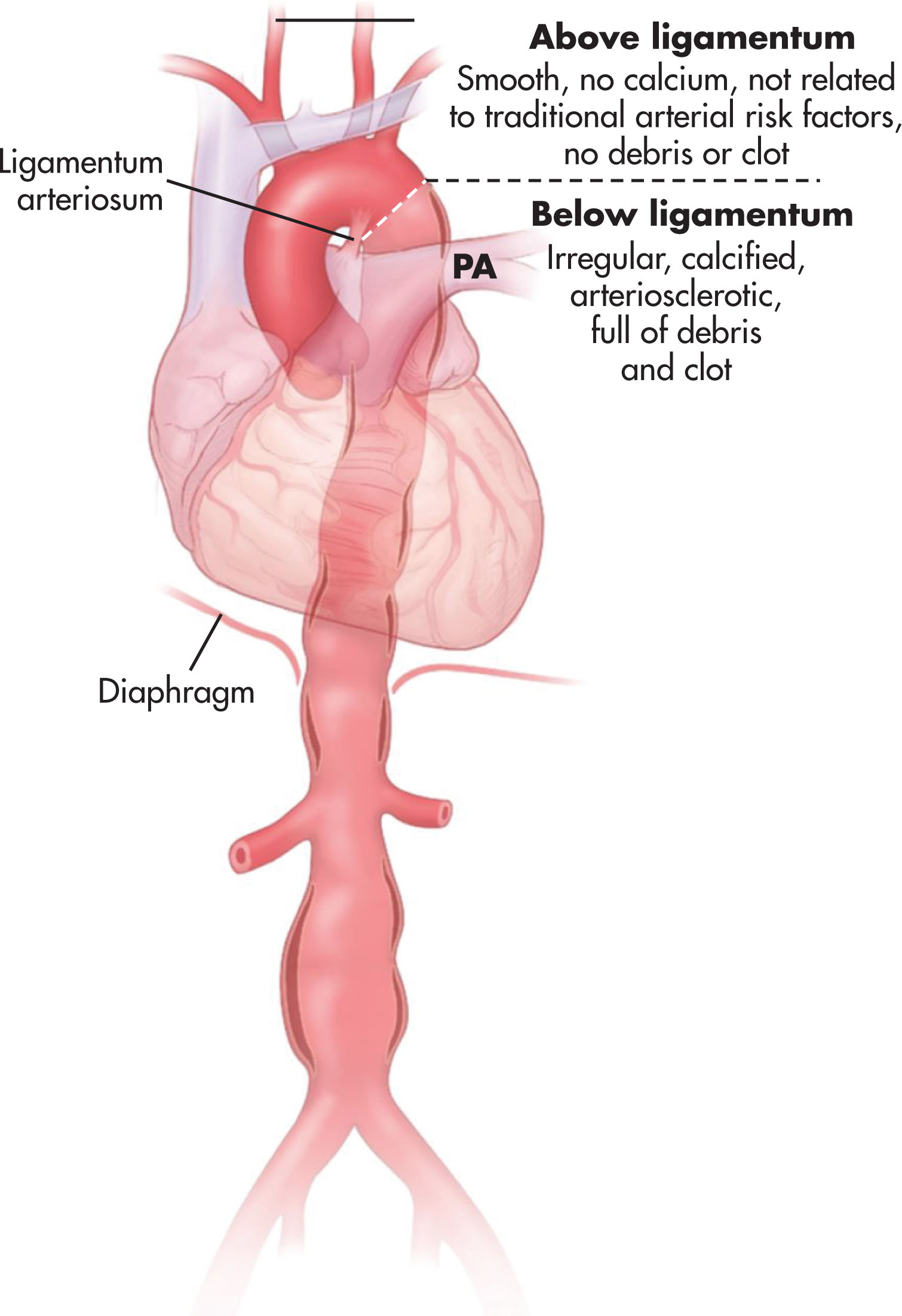
Arteriosclerosis occurs when the arterial vascular system becomes thick and stiff, leading to blood flow restriction to the organs and tissues in the body. Normal healthy arteries are flexible and elastic. With the development of arteriosclerosis, the walls in the arteries can harden and stiffen, resulting in higher blood pressure. Atherosclerosis is a specific form of arteriosclerosis. These terms are often used interchangeably. The buildup of fats, cholesterol, and other substances within the arterial wall (known as plaque ) can restrict blood flow ( Fig. 8.27 ). These plaques may burst and trigger a blood clot or thrombus to form in the artery. The disease usually affects the ascending and descending aorta but can be found in any arterial vessel in the body. Atherosclerosis is preventable and treatable with medication and lifestyle changes. The disease process develops gradually so patients do not have early warning symptoms until the plaque ruptures or obstructs the blood flow.
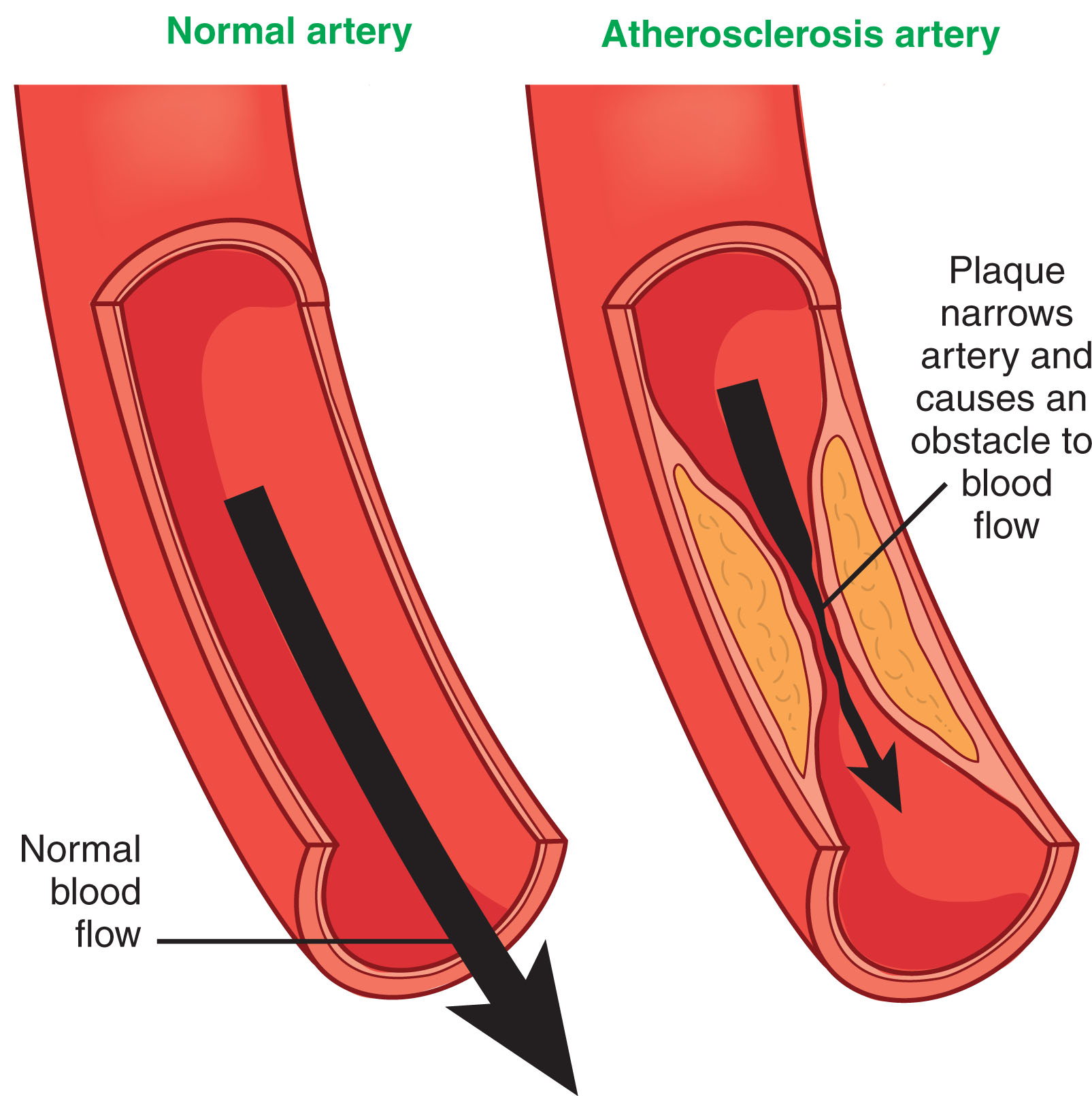
Symptoms of moderate to severe atherosclerosis depend on which arteries are affected:
Heart—chest pain or pressure (angina)
Brain—sudden numbness or weakness in arms or legs, difficulty speaking or slurred speech, or drooping muscles in the face
Arms and legs—leg pain when walking or exercising (intermittent claudication)
Kidneys—high blood pressure or kidney failure
Atherosclerosis is a slow, progressive disease. The damage builds over the years and is caused by many factors, including elevated blood pressure, high cholesterol, high triglycerides, smoking, diabetes, inflammation from systemic diseases such as arthritis or lupus, or infections. Other risk factors include family history of heart disease and lack of exercise. Once the wall of the artery is damaged, the cells clump at the injury site to build up in the inner lining of the artery. These fatty deposits harden and cause narrowing the vessel, thus preventing the organs and tissue the proper blood supply. These fatty deposits may break off and enter the bloodstream to cause a blood clot that may embolize anywhere in the body. Arteriosclerosis is most commonly associated with the development of an aneurysm.
An abdominal aortic aneurysm (AAA) is a localized dilation of the abdominal aorta, usually greater than 3 cm in diameter or more than 1.5 times the diameter of the proximal aorta. The force of blood pushing against the walls of an artery combined with damage or injury to the artery’s walls may cause an aneurysm. The abdominal aorta is more common than the thoracic aorta for aneurysm formation ( Fig. 8.28 ). The aneurysm may develop over years without the patient complaining of symptoms. Symptoms may not occur until the pressure of the aneurysm compresses adjacent organs, causes a blockage of blood flow, or ruptures into the abdominal or thoracic cavity. The primary risk factors for a patient with an AAA are dissection and rupture of the vessel. Dissection occurs when the force of blood pumping splits the arterial wall layers, allowing blood to leak in between the walls. The critical condition is when the aneurysm ruptures, causing bleeding internally. Catastrophic outcomes may result from an aortic dissection or rupture. Box 8.2 summarizes the features of AAAs.
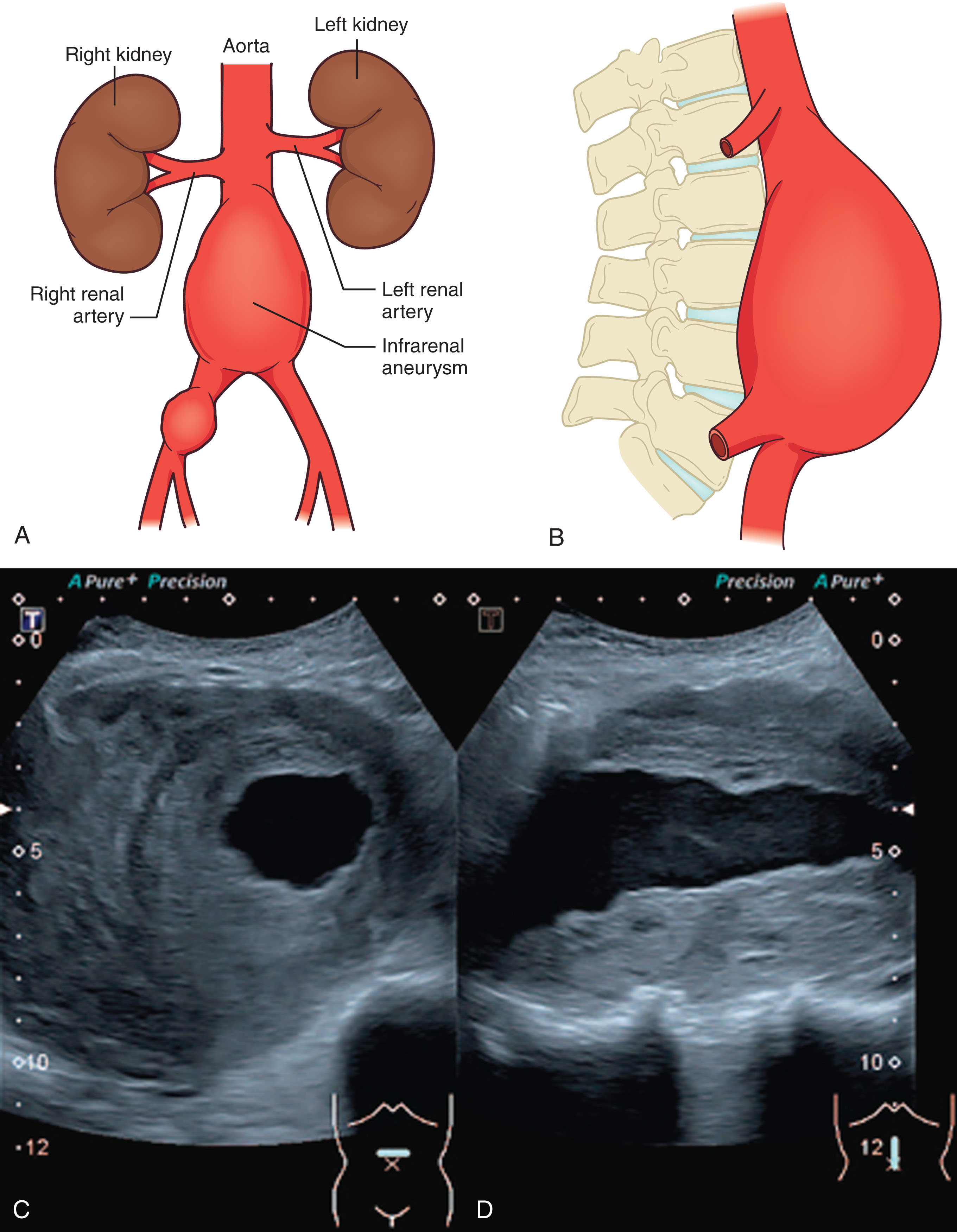
Most are true aneurysms, involving all three layers
Approximately 85% are infrarenal
Measure anteroposterior diameter on longitudinal views
Mural thrombus common with larger aneurysm
Atherosclerosis—tortuosity, folding
Aortic pseudoaneurysm—trauma
Mycotic aneurysm—infection
Surgery may be considered when >5 cm
Risk factors that contribute to the development of an aneurysm include tobacco use, hypertension, and other cardiovascular diseases. Other risk factors include chronic obstructive pulmonary disease and positive family history for AAA. Genetic conditions linked to AAA include Marfan syndrome and Ehlers-Danlos syndrome ( Box 8.3 ).
Atherosclerosis
Trauma to the chest
Congenital defects (aortic sinus, post-coarctation of the aorta, ductus diverticulum)
Syphilis (involving the ascending aorta and arch)
Mycosis (fungal dissection)
Cystic medial necrosis (e.g., Marfan syndrome)
Inflammation of media and adventitia (e.g., rheumatic fever, polychondritis, ankylosing spondylitis)
Increased pressure (systemic hypertension, aortic valve stenosis)
Abnormal volume load (severe aortic regurgitation)
AAA occurs more commonly in men over age 65 in the United States compared with women. Visualization of the abdominal aorta has traditionally been an asset in diagnosing the clinical problem. Ultrasound is very capable of demonstrating abnormalities in the diameter, length, and extent of the AAA. The majority of AAAs occur below the kidneys (infrarenal), with the remainder occurring at the level of or above the kidneys ( Fig. 8.29 ). The diagnosis of an aneurysm depends on comparing the aortic diameter of the suspicious area versus that of the normal area of the vessel above and below that area. The sonographer should note the relationship of the aortic aneurysm to the renal arteries. Thus the diameter and the longitudinal extent of the aneurysm as it relates to the origin of the renal vessels should be measured. Often bowel gas may impair adequate visualization of the renal arteries; therefore a more indirect method must be used to locate the origin of the superior mesenteric artery and renal arteries. The patient should be examined from both the supine and the left flank, with the patient rolled into a right lateral decubitus position. Color Doppler may be useful for producing an image of arterial flow from the lateral margins of the abdominal aorta to the kidneys.
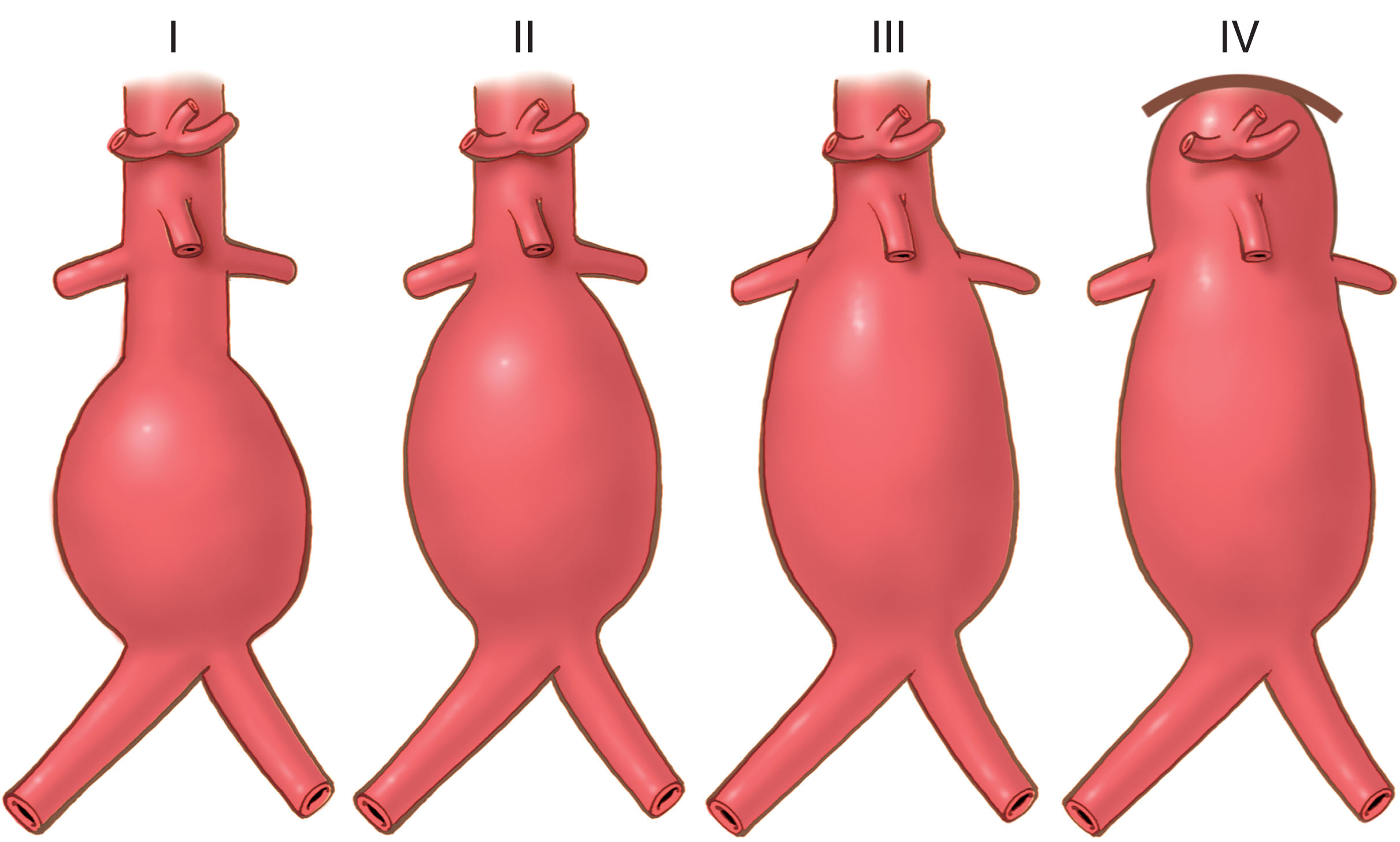
Become a Clinical Tree membership for Full access and enjoy Unlimited articles
If you are a member. Log in here